Yachting Monthly
- Digital edition


Sailing in lightning: how to keep your yacht safe
- In partnership with Katy Stickland
- July 22, 2022
How much of a concern is a lightning strike to a yacht and what can we do about it? Nigel Calder looks at what makes a full ‘belt and braces’ lightning protection system

Storm clouds gather at Cowes, but what lightning protection system, if any, does your boat have for anchoring or sailing in lightning? Credit: Patrick Eden/Alamy Stock Photo
Most sailors worry about sailing in lightning to some extent, writes Nigel Calder .
After all, going around with a tall metal pole on a flat sea when storm clouds threaten doesn’t seem like the best idea to most of us.
In reality, thunder storms need plenty of energy, driven by the sun, and are much less frequent in northern Europe than in the tropics.
However, high currents passing through resistive conductors generate heat.
Small diameter conductors melt; wooden masts explode; and air gaps that are bridged by an arc start fires.

Sailing in lightning: Lightning is 10 times more likely over land than sea, as the land heats up more than water, providing the stronger convection currents needed to create a charge. Credit: BAE Inc/Alamy Stock Photo
On boats, radio antennas may be vaporised, and metal thru-hulls blown out of the hull, or the surrounding fiberglass melted, with areas of gelcoat blown off.
Wherever you sail, lightning needs to be taken seriously.
Understanding how lightning works, will help you evaluate the risks and make an informed decision about the level of protection you want on your boat and what precautions to take.
Most lightning is what’s called negative lightning, between the lower levels of clouds and the earth. Intermittent pre-discharges occur, ionising the air.
Whereas air is normally a poor electrical conductor, ionised air is an excellent conductor.
These pre-discharges (stepped leaders) are countered by a so-called attachment spark (streamer), which emanates from pointed objects (towers, masts, or lightning rods) that stand out from their surroundings due to their height.

Summer is the season for lightning storms in the UK. Here, one finds early at Instow, Devon. Credit: Terry Matthews/Alamy Stock Photo
This process continues until an attachment spark connects with a stepped leader, creating a lightning channel of ionised air molecules from the cloud to ground.
The main discharge, typically a series of discharges, now takes place through the lightning channel.
Negative lightning bolts are 1 to 2km (0.6 to 1.2 miles) long and have an average current of 20,000A.
Positive lightning bolts are much rarer and they can have currents of up to 300,000A.
Preventing damage when sailing in lightning
A lightning protection system (LPS) is designed to divert lightning energy to ground (in this case the sea), in such a way that no damage occurs to the boat or to people.
Ideally, this also includes protecting a boat’s electrical and electronic systems, but marine electronics are sensitive and this level of protection is hard to achieve.
Lightning protection systems have two key components: First, a mechanism to provide a path with as little resistance as possible that conducts a lightning strike to the water.
This is established with a substantial conductor from an air-terminal to the water.

Components of an external and internal lightning protection system. Credit: Maxine Heath
This part of the LPS is sometimes called external lightning protection.
Second, a mechanism to prevent the development of high voltages on, and voltage differences between, conductive objects on the boat.
This is achieved by connecting all major metal objects on and below deck to the water by an equipotential bonding system.
Without this bonding system high enough voltage differences can arise on a boat to develop dangerous side flashes.
The bonding system can be thought of as internal lightning protection.
Rolling ball concept
Lightning standards, which apply ashore and afloat, define five lightning protection ‘classes’, ranging from Class V (no protection) to Class I.
There are two core parameters: the maximum current the system must be able to withstand, which determines the sizing of various components in the system, and the arrangement and number of the air terminals, aka lightning rods.
Let’s look at the arrangement of the air terminals first. It is best explained by the rolling ball concept.
A lightning strike is initiated by the stepped leaders and attachment sparks connecting to form the lightning channel.
The distance between the stepped leader and the attachment sparks is known as the breakdown distance or striking distance.
If we imagine a ball with a radius equal to the striking distance, and we roll this ball around an object to be protected, the upper points of contact define the possible lightning impact points that need to be protected by air terminals.

Lightning protection theories and classifications rely on a ‘rolling ball’ concept to define requirements, areas of risk and protected areas. Credit: Maxine Heath
The air terminal will theoretically provide a zone of protection from the point at which the terminal connects with the circumference of the rolling ball down to the point at which that circumference touches the water.
The shorter the striking distance, the less the radius of the rolling ball and the smaller the area within the protection zone defined by the circumference of the rolling ball.
The smaller the protection zone, the more air terminals we need. So, we use the shortest striking distance to determine the minimum number and location of air terminals.
Class I protection assumes a rolling ball radius of 20m; Class II assumes a rolling ball radius of 30m.
Continues below…

Lightning: why we were struck
A personal investigation into how and why a catamaran was hit by lightning

‘Lightning destroyed the boat’s electronics’
Paul Tinley recounts a truly shocking lightning experience aboard his Beneteau 393 Blue Mistress and the subsequent insurance claim

Expert advice: boating emergency
A boating emergency is the sort of thing that everyone taking to the water should be prepared for even if,…

How batteries can explode – and how to avoid it
Marine electrical expert Nigel Calder explains why boat batteries emit hydrogen and how to minimise the dangers
Boat building standards are based on a striking distance/rolling ball radius of 30m (Class II).
For masts up to 30m above the waterline, the circumference of the ball from the point at which it contacts the top of the mast down to the water will define the zone of protection.
For masts higher than 30m above the waterline, the ball will contact the mast at 30m and this will define the limit of the zone of protection.
If Class I protection is wanted, the radius of the ball is reduced to 20m, which significantly reduces the zone of protection and, on many larger recreational boats, may theoretically necessitate more than one air terminal.
Protection classes
With most single-masted monohull yachts, an air terminal at the top of the mast is sufficient to protect the entire boat to Class I standards.
The circumference of the rolling ball from the tip of the mast down to the surface of the water does not intercept any part of the hull or rig.
However, someone standing on the fore or aft deck might have the upper part of their body contact the rolling ball, which tells us this is no place to be in a lightning storm.
Some boats have relatively high equipment or platforms over and behind the cockpit.

Protection classes to protect your boat while anchored or sailing in lightning
These fittings and structures may or may not be outside the circumference of the rolling ball.
Once again, this tells us to avoid contact with these structures during a lightning storm.
Ketch, yawl, and schooner rigged boats generally require air terminals on all masts, except when the mizzen is significantly shorter than the main mast.
The external LPS
The external LPS consists of the air terminal, a down conductor, and an earthing system – a lightning grounding terminal.
The down conductor is also known as a primary lightning protection conductor.
All components must be sized to carry the highest lightning peak current corresponding to the protection class chosen.
In particular, the material and cross-sectional area of the air terminal and down conductor must be such that the lightning current does not cause excessive heating.
The air terminal needs to extend a minimum of 150mm above the mast to which it is attached.

A graph depicting NASA’s record of yearly global lightning events. The Congo once recorded more than 450 strikes per km2
It can be a minimum 10mm diameter copper rod, or 13mm diameter aluminum solid rod.
It should have a rounded, rather than a pointed, top end.
VHF antennas are commonly destroyed in a lightning strike.
If an antenna is hit and is not protected by a lightning arrestor at its base, the lightning may enter the boat via the antenna’s coax cable.
A lightning arrestor is inserted in the line between the coax cable and the base of the antenna.
It has a substantial connection to the boat’s grounding system, which, on an aluminum mast, is created by its connection to the mast.
In normal circumstances, the lightning arrestor is nonconductive to ground.
When hit by very high voltages it shorts to ground, in theory causing a lightning strike to bypass the coax – although the effectiveness of such devices is a matter of some dispute.
Down conductors
A down conductor is the electrically conductive connection between an air terminal and the grounding terminal.
For many years, this conductor was required to have a resistance no more than that of a 16mm² copper conductor, but following further research, the down conductor is now required to have a resistance not greater than that of a 20mm² copper conductor.
For Class I protection, 25mm² is needed. This is to minimise heating effects.
Let’s say instead we use a copper conductor with a cross-sectional area of 16mm² and it is hit by a lightning strike with a peak current corresponding to Protection Class IV.

Sailing in lightning: This catamaran relies upon cabling to ground from the shrouds but stainless steel wire is not a good enough conductor. Credit: Wietze van der Laan
The conductor will experience a temperature increase of 56°C. A 16mm² conductor made of stainless steel (for example, rigging ) will reach well over 1,000°C and melt or evaporate.
Shrouds and stays on sailboats should be connected into a LPS only to prevent side flashes.
The cross-sectional area of the metal in aluminum masts on even small sailboats is such that it provides a low enough resistance path to be the down conductor.
Whether deck- or keel-mounted, the mast will require a low resistance path, equivalent to a 25mm² copper conductor, from the base of the mast to the grounding terminal.
Grounding terminal
Metal hulled boats can use the hull as the grounding terminal. All other boats need an adequate mass of underwater metal.
In salt water this needs a minimum area of 0.1m². In fresh water, European standards call for the grounding terminal to be up to 0.25m².
A grounding terminal must be submerged under all operating conditions.
An external lead or iron keel on monohull sailing boats can serve as a grounding terminal.

This owner of this Florida-based yacht decided to keep the keel out of the equation when is came to a grounding plate. High electrical currents don’t like sharp corners, so a grounding plate directly beneath the mast makes for an easier route to ground. Credit: Malcolm Morgan
In the absence of a keel , the cumulative surface area of various underwater components – propellers, metal thru-hulls, rudders – is often more than sufficient to meet the area requirements for a grounding terminal.
However, these can only be considered adequate if they are situated below the air terminal and down conductor and individually have the requisite surface area.
Metal through-hulls do not meet this requirement.
If underwater hardware, such as a keel, is adequate to be used as the grounding terminal, the interconnecting conductor is part of the primary down conductor system and needs to be sized accordingly at 25mm².
Propellers and radio ground plates
Regardless of its size, a propeller is not suitable as a grounding terminal for two reasons.
First, it is very difficult to make the necessary low-resistance electrical connection to the propeller shaft, and second, the primary conductor now runs horizontally through the boat.
The risk of side flashes within the boat, and through the hull to the water is increased.

Sailing in lightning: GRP hull, fairing filler and iron keel will have carried different voltages during the strike – hence this damage
An engine should never be included in the main (primary) conducting path to a grounding terminal.
On modern engines, sensitive electronic controls will be destroyed in a lightning strike, and on all engines, oil in bearings and between gears will create resistance and therefore considerable heat which is likely to result in internal damage.
However, as it is a large conductive object, the engine should be connected to the internal lightning protection system.
Internal lightning protection
On its way to ground, lightning causes considerable voltage differences in adjacent objects – up to hundreds of thousands of volts.
This applies to boats with a functioning external lightning protection system but without internal protection.
Although the lightning has been given a path to ground along which it will cause as little damage as possible, dangerous voltages can be generated elsewhere, resulting in arcing and side flashes, threatening the boat and crew, and destroying electronic equipment.
We prevent these damaging voltage differences from arising by connecting all substantial metal objects on the boat to a common grounding point.

One of the holy grails of marine photography – a direct lightning strike on a yacht’s mast. Credit: Apex
The grounding terminal is also wired to the common grounding point.
By tying all these circuits and objects together we hold them at a common voltage, preventing the build-up of voltage differences between them.
All conductive surfaces that might be touched at the same time, such as a backstay and a steering wheel, need to be held to the same voltage.
If the voltages are the same, there will be no arcing and no side flashes.
The bonding conductors in this internal LPS need to be stranded copper with a minimum size of 16mm².
Note that there can be bonding of the same object for corrosion prevention, lightning protection, and sometimes DC grounding.
We do not need three separate conductors.
Electronic Device Protection
With lightning protection systems, we need to distinguish electric circuit and people protection from device protection.
Even with an internal LPS, high induced voltages may occur on ungrounded conductors (such as DC positive) which will destroy any attached electronics.
A mechanism is needed to short high transient voltages to ground.
This is done with surge protection devices (SPD), also known as transient voltage surge suppressors (TVSS) or lightning arrestors.

Marine-specific SPDs are few in number and domestic models are not suitable for boats
In normal circumstances these devices are non-conductive, but if a specified voltage – the clamping voltage – is exceeded they divert the spike to ground.
There are levels of protection defined in various standards depending on the voltages and currents that can be handled, the speed with which this occurs, and other factors.
This is a highly technical subject for which it is advisable to seek professional support.
Most SPDs are designed for AC circuits.
When it comes to DC circuits there are far fewer choices available to boat owners although there are an increasing number for solar installations that may be appropriate.
There is no such thing as a lightning-proof boat, only a lightning-protected boat, and for this there needs to be a properly installed LPS.

Nigel Calder is a lifelong sailor and author of Boatowner’s Mechanical and Electrical Manual. He is involved in setting standards for leisure boats in the USA
Even so, in a major strike the forces involved are so colossal that no practical measures can be guaranteed to protect sensitive electronic equipment.
For this, protection can be provided with specialised surge protection devices (SPDs).
The chances of a direct lightning strike on a yacht are very small, and the further we are north or south of the equator, the smaller this chance becomes.
It’s likely your chances of receiving a direct lightning strike are very much higher on a golf course than at sea.
‘Bottle brush’-type lightning dissipators are claimed by sellers to make a boat invisible to lightning by bleeding off static electrical charge as it builds up.
The theory rests upon the concept that charged electrons from the surface of the earth can be made to congregate on a metal point, where the physical constraints caused by the geometry of the point will result in electrons being pushed off into the surrounding atmosphere via a ‘lightning dissipator’ that has not just one point, but many points.
It is worth noting that the concept has met with a storm of derision from many leading academics who have argued that the magnitude of the charge that can be dissipated by such a device is insignificant compared to that of both a cloud and individual lightning strikes.
It seems that the viable choices for lightning protection remain the LPS detailed above, your boatbuilder’s chosen system (if any), or taking one’s chances with nothing and the (reasonable) confidence that it’s possible to sail many times round the world with no protection and suffer no direct strikes.
Whichever way you go, it pays to stay off the golf course!
Enjoyed reading Sailing in lightning: how to keep your yacht safe?
A subscription to Yachting Monthly magazine costs around 40% less than the cover price .
Print and digital editions are available through Magazines Direct – where you can also find the latest deals .
YM is packed with information to help you get the most from your time on the water.
- Take your seamanship to the next level with tips, advice and skills from our experts
- Impartial in-depth reviews of the latest yachts and equipment
- Cruising guides to help you reach those dream destinations
Follow us on Facebook , Twitter and Instagram.

Service Locator
- Angler Endorsement
- Boat Towing Coverage
- Mechanical Breakdown
- Insurance Requirements in Mexico
- Agreed Hull Value
- Actual Cash Value
- Liability Only
- Insurance Payment Options
- Claims Information
- Towing Service Agreement
- Membership Plans
- Boat Show Tickets
- BoatUS Boats For Sale
- Membership Payment Options
- Consumer Affairs
- Boat Documentation Requirements
- Installation Instructions
- Shipping & Handling Information
- Contact Boat Lettering
- End User Agreement
- Frequently Asked Questions
- Vessel Documentation
- BoatUS Foundation
- Government Affairs
- Powercruisers
- Buying & Selling Advice
- Maintenance
- Tow Vehicles
- Make & Create
- Makeovers & Refitting
- Accessories
- Electronics
- Skills, Tips, Tools
- Spring Preparation
- Winterization
- Boaters’ Rights
- Environment & Clean Water
- Boat Safety
- Navigational Hazards
- Personal Safety
- Batteries & Onboard Power
- Motors, Engines, Propulsion
- Books & Movies
- Cockpit Confessions
- Communication & Etiquette
- Contests & Sweepstakes
- Colleges & Tech Schools
- Food, Drink, Entertainment
- New To Boating
- Travel & Destinations
- Watersports
- Anchors & Anchoring
- Boat Handling
- ← Safety & Prevention
Modern Lightning Protection On Recreational Watercraft
Advertisement
While you can't prevent a strike, there's a lot you can do to mitigate — or even prevent — damage.
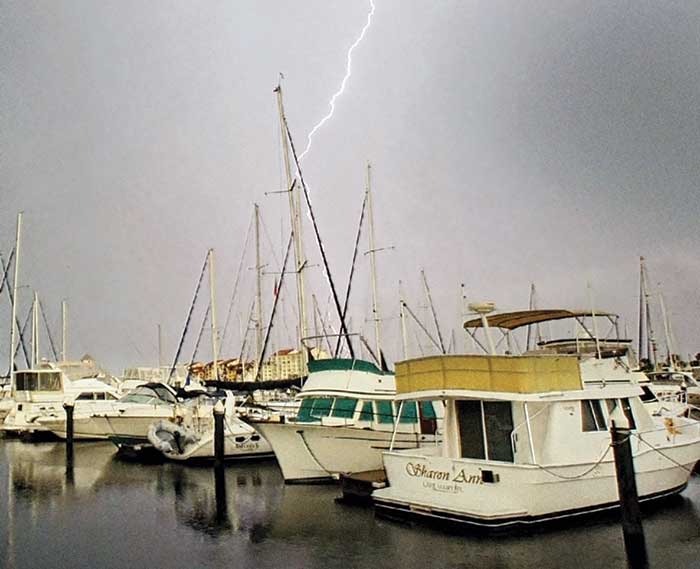
A thunderstorm passing over a marina has the potential to cause expensive damage.
The recent advances in electrical and electronic systems have revolutionized recreational boating. Vessel operations have been simplified and the boating experience enhanced due to the integration of electronics into almost every onboard system, from navigation and communications to propulsion and maneuvering. Complex engine electronics known by various names including Engine Control Unit (ECU) and Engine Control Module (ECM) have increased performance and reduced emissions on modern engines. However, these advances have come at a cost. Many 21st-century boaters depend on electronic systems to navigate and maneuver their boats, and many modern engines will not function if their electronics are compromised. That makes modern mariners and their boats vulnerable to a lightning strike that damages these now mission-critical systems, potentially leaving the boat dead in the water without navigation or communications equipment.
Unfortunately, sensitive electronics on boats have become increasingly vulnerable to lightning strikes, yet lightning-protection systems have not kept pace. It's not that there haven't been significant advances in lightning science since Benjamin Franklin developed his theories on how to protect barns and livestock. The National Fire Protection Association, Underwriters Laboratories, and industries which are significantly at risk from lightning, such as telecommunications, wind generation, aviation, and fuel, have achieved consensus on the science of lightning protection and have embraced new protocols and practices. But the recreational boating industry has been slow to adapt those changes to the marine environment. There are at least three reasons for that.
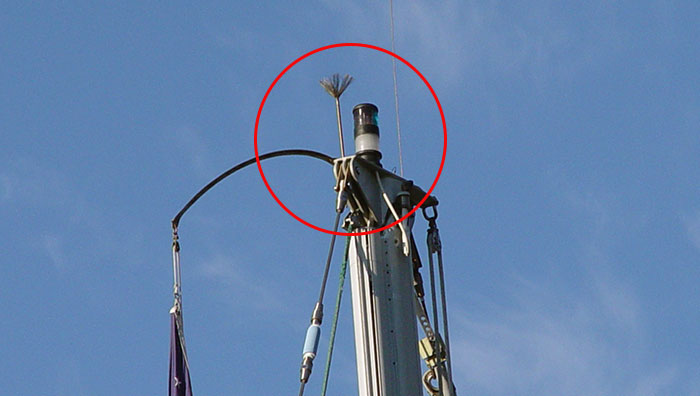
There is no evidence from independent laboratories that these fuzzy lightning dissipators prevent strikes.
First, corrosion and motion on board boats, as well as limitations with respect to weight, space, and geometry, make lightning protection more challenging than in shoreside installations. Second, the mandate of the standards body for the industry, the American Boat & Yacht Council (ABYC), focuses on protecting life; protecting equipment has been a lower priority. Third, there has been strong disagreement between professionals about the best way to mitigate damage in a lightning strike and precious little data to support one point of view over another. The sometimes-raucous debate surrounding certain unproven lightning- protection devices and such theories as "fuzzy" lightning dissipation terminals and early-streamer emission terminals, as well as unorthodox placement of grounding terminals (a.k.a. grounding plates), have sharply divided the recreational boating technical community, all of which makes consensus on lightning protection difficult, if not impossible.
This lack of guidance is frustrating for those with boats at risk. While a runabout in Portland, Oregon, or a daysailer in Portland, Maine, may have little risk of lightning damage (see " Striking Lightning Facts "), larger vessels (particularly sailboats) in such lightning-prone areas as the Chesapeake Bay or Florida absolutely should be protected using the best technology available. Any marine-insurance adjuster can attest that the potential for loss on these vessels can be great. The National Fire Protection Association made some fundamental changes to the watercraft chapter of NFPA 780: Standard for the Installation of Lightning Protection Systems in 2008 that incorporate the thinking that has become accepted in other industries. While the recommendations in NFPA 780 have yet to be embraced by the recreational boating industry as a whole, understanding what it says — and why — may assist you in developing a lightning-protection plan for your boat.
Lightning 101
The simplest way to think of a lightning strike would be as a short circuit between the cloud and the earth. The earth and an active thundercloud have either a positive or a negative polarity with respect to each other, just like battery connections that can arc if they are not separated by a long enough air gap. Whether the positive charge is in the cloud or on the water may have great importance to a physicist, but matters little to the cow in the barn or the VHF radio antenna on the mast.
The important point is that the earth (or in our case, the water) contains an unlimited supply of positive and negative charges; it is the thundercloud that induces the charge concentration in the water. For example, if a large concentration of negative charge coalesces in a storm cloud over the ocean, a large concentration of positive charge is drawn to the very top surface of the water directly beneath it. (Opposites attract.) Since air is a good insulator, no electricity will flow between the cloud and the water unless the airborne charge loses altitude, moves close enough to the surface of the water, and the lightning jumps the gap. If an electrically conductive material, such as an aluminum tuna tower or mast, stainless steel rigging, or a long vertical copper wire, comes between the cloud and the water, then the gap that must be jumped becomes shorter. The boat short circuits the voltage, much like a wrench across battery terminals.
Because boats are built from electrically conductive components installed between the water and the areas aloft (masts, rigging, antennas, towers, support structures, electrical wiring), a lightning strike is inevitable if an active thundercloud containing electrical charges passes overhead at a low enough altitude. How much damage the lightning strike does to the boat depends upon how easily the electrical energy from the strike can find its way through the boat to ground. There will be a lot less damage if the discharge is contained in a well-designed lightning-protection system than if it takes a detour through the ship's wiring and sensitive electronics on its way out of the boat.
This is a basic concept that surprises many boaters: A lightning-protection system is not designed to prevent a lightning strike, but rather to provide a safe discharge path for the lightning. This is the only viable solution for lightning protection (short of going back to wooden ships, kerosene lamps, and sextants). The technology to prevent lightning strikes does not yet exist.
Still, there are devices out there claiming to do just that. Lightning dissipaters (LDs) look like metal bottle brushes or frayed paint brushes and are installed on the top of the mast. The hypothesis is that the numerous conductive points on the LDs safely dissipate accumulated charges so the lightning strike will not occur. As far as I am aware, not a single independent testing laboratory has confirmed the effectiveness of lightning dissipaters as lightning preventers.
Early-streamer emission (ESE) terminals have also gained traction in some circles. Fancy lightning rods often shaped like a torpedo that usually come with electronic circuitry, these are supposed to attract lightning better than a standard lightning rod (also called an air terminal), to ensure that the lightning strikes the grounding path rather than what is being protected. Once again, I am not aware of any independent studies validating the effectiveness of these devices.
Lightning-protection systems actually function by acting as the "best" short circuit between the cloud and the water, one designed to lead the lightning harmlessly to ground. The system accomplishes this in two ways: by attracting lightning away from more destructive pathways between cloud and ground, and by sending the charge around, instead of through, what it is protecting.
The first concept has traditionally been known as the "cone of protection" or the area protected by an air terminal from a strike. Traditionally, the cone of protection has been thought to include a circle centered on the base of the air terminal whose radius equals the height of the terminal and to extend from the top of the air terminal to the ground at a 45 degree angle. In fact, the length of the final jump that lightning takes before striking the air terminal is about 30 meters. Recent research suggests that the actual area protected can be defined by an imaginary sphere with this radius that is "rolled" up to the air terminal. All objects inside the imaginary sphere will not be protected by the air terminal, which means the area protected often differs in size and shape from the cone of protection model. Modern lightning protection for airports and power plants use the rolling sphere method and place air terminals so that the areas of protection overlap and include any sensitive equipment that would be damaged by a strike.
The second concept will be familiar to many as the Faraday cage. As early as 1836, Michael Faraday discovered that objects surrounded by metal were protected from lightning (explaining why we are safe from lightning while in our cars). Many old-school sailors have used Faraday's discovery to good purpose when they placed sensitive electronics in the oven during a lightning storm (with the oven off, of course.) This practice can be significantly updated by placing sensitive electronics in the microwave oven!
21st Century Lightning Protection
Benjamin Franklin pioneered lightning protection in 1749 with the invention of the lightning rod, and, when it comes to recreational boats, until recently, little has changed. Under his model, the lightning is attracted to the lightning rod (air terminal), which then passes the lightning current harmlessly to a submerged metaevent secondary flashes from these metal structures.
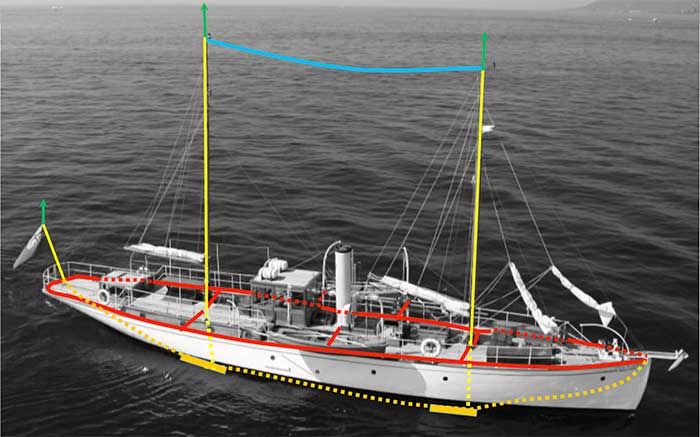
Air Terminals are shown in green; grounding plates with down, side flash, and equalization conductors in yellow; loop conductors in red; and catenary conductors in blue.
NFPA 780 draws much from the old-school system while incorporating improvements based on the modern understanding of lighting protection. While solutions will vary depending on the boat, let's talk about the basics.
Air terminals (lightning rod or Franklin rod) should be installed at the highest points of masts, towers, etc. On a sailboat a single air terminal could be bolted to the mast; on a sportfish it could be bolted to the tower and made to look like an antenna. This should be higher than anything you are trying to protect from a lightning strike, such as a VHF antenna.
A heavy electrical conductor should be connected from each air terminal directly down to a grounding point on the hull. In the case of a sailboat's mast, aluminum is a good conductor, so no separate wiring run needs to be installed. (Note that the wiring inside of the mast will be protected due to the Faraday effect.) An aluminum tower will work the same way on a sportfish so long as the legs are connected to an adequate grounding plate. Where no aluminum structure exists to act as a down conductor, a 4 AWG wire or larger should be run from the air terminal to the grounding plate in as straight a run as possible and well separated from other wiring.
The grounding point should be a corrosion-resistant metal plate installed on the exterior of the hull below the waterline. The plate should be at least one square foot in size and at least 3/16 of an inch thick. Research shows that most of the electrical discharge occurs along the edges, so a long, narrow plate, especially one with grooves cut in it, will be most effective at dispersing the charge. A new major point of contention is where to install the grounding plate, or plates. Some research indicates that a location at or near the waterline is by far the most effective solution. On a sailboat, the lead keel can be used as the grounding plate if the keel is not fiberglass-encapsulated or covered in fairing. If the mast is solidly keel stepped, there would be no need for a separate conductor from the mast to the keel. Metal rudders or propeller struts are also acceptable as grounding plates.
Protecting Electronics
Surge-protective devices (SPD) or transient voltage surge suppressors (TVSS) should be installed on all equipment that's mission critical, expensive, difficult to replace, and/or prone to lightning damage. Examples include the ECU/ECM, alarm systems, chartplotters, and instruments.
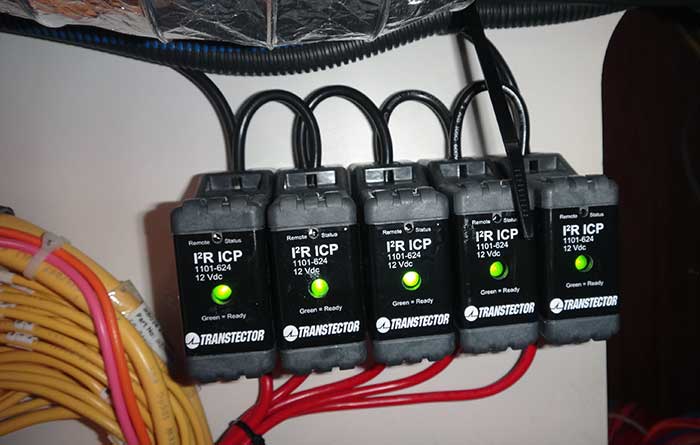
A bank of TVSSs protecting sensitive electronics.
TVSSs are the most exciting development in the field of lightning protection. These semiconductor devices provide protection by suppressing lightning-related voltage spikes. They are widely used in the telecommunications, wind generation, and avionics industries.
TVSSs are connected across the input terminals supplying voltage to a piece of equipment; they can be thought of as fuses that react to voltage instead of current. The TVSS is an open circuit as long as the supply voltage feeding the equipment is in the normal range. However, if a lightning strike causes a momentary voltage spike and puts, say 1,000 volts on a 120-volt device, the TVSS will "clamp" or short circuit 880 volts and convert it to heat. The excessive heat could, and probably would, damage the TVSS; but destroying a $250 surge arrestor to protect a $5,000 engine controller is good engineering.
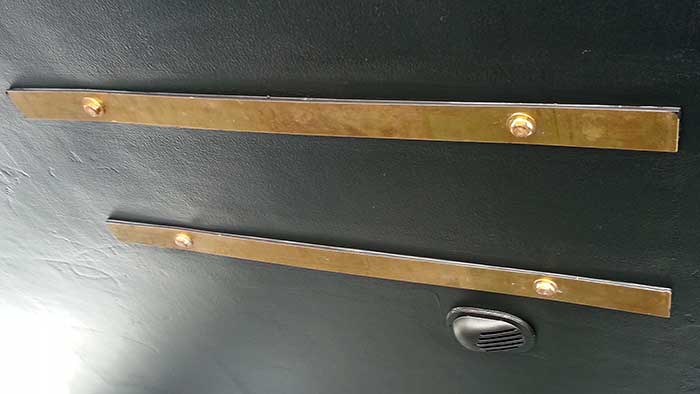
Grounding plates should be long and narrow with groves cut into them to disperse the charge more efficiently.
Voltage surge protection would be prudent for engine controls, navigation systems, steering systems, and shorepower systems. TVSSs come in many voltage ratings, energy ratings, response times, and so on. Some are designed to protect whole distribution systems, while others are suitable for individual equipment protection only. A well-designed system includes cascaded protection, with extra protection on mission-critical and lightning-prone equipment, such as main engines and shorepower systems. The key to a reliable and cost-effective system is to ensure that appropriately rated devices are specified and properly installed. The best TVSS in the world will be ineffective if it is not connected properly.
Despite the best technology, there can still be challenges with an NFPA 780-based system, particularly when the system is improperly or only partially installed. For example, if the air terminal is installed lower than an adjacent antenna, it will not protect the antenna; in that case, the antenna cable carries the lightning current. Also, if the down conductor is connected to the bonding system rather than directly to a dedicated grounding terminal (ground plate), the lightning strike can energize the entire bonding system before discharging into the water. Another common mistake is to secure the lightning down conductor to other wiring. The high current from a strike through the down conductor can result in voltage surges in these adjacent wires, leading to additional damage in equipment that would otherwise be completely unaffected by the lightning strike.
In Conclusion
The recent revolution in marine electronics demands an evolution of our thinking on marine lightning-protection; equipment protection should be an important aspect of any modern lightning protection system. The knowledge and resources to safely transform this change in thinking into reality are readily available, both from the NFPA and industries also at risk from lightning. However, there are unique challenges on pleasure craft that are not addressed by others. These must be solved by sharing the experiences of lightning-protection systems and their effectiveness across the industry.
Related Articles
The truth about ceramic coatings for boats.
Our editor investigates the marketing claims of consumer-grade ceramic coatings.
Fine-Tune Your Side Scan Fishfinder
Take your side-scanning fishfinder off auto mode, and you’ll be spotting your prey from afar in no time
DIY Boat Foam Decking
Closed-cell foam flooring helps make boating more comfortable. Here’s how to install it on your vessel
Click to explore related articles
James Coté
Contributor, BoatUS Magazine
James Coté is an electrical engineer, ABYC Master Technician, Fire Investigator and Marine Investigator. He operates a marine electric and corrosion control consulting firm located in Florida. For more information, go to: cotemarine.net
BoatUS Magazine Is A Benefit Of BoatUS Membership
Membership Benefits Include:
Subscription to the print version of BoatUS Magazine
4% back on purchases from West Marine stores or online at WestMarine.com
Discounts on fuel, transient slips, repairs and more at over 1,200 businesses
Deals on cruises, charters, car rentals, hotel stays and more…
All for only $25/year!
We use cookies to enhance your visit to our website and to improve your experience. By continuing to use our website, you’re agreeing to our cookie policy.

- Center Consoles
- Dual Consoles
- Motoryachts
- Sport Cruisers
- Tenders & Ribs
- U.S. Atlantic
- Engine Buyers Guide
- Electronics
- Digital Edition
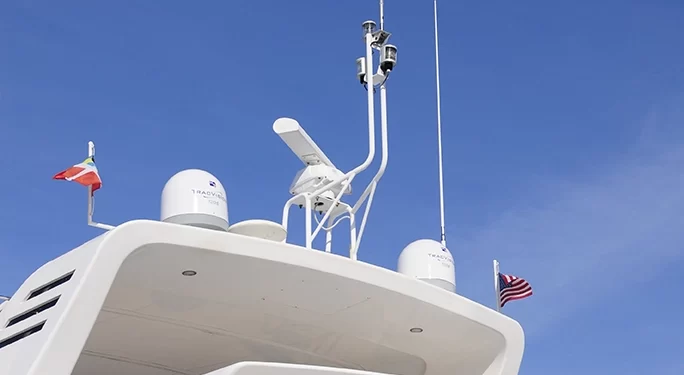
A Quick Comprehensive Guide to Lightning Protection for Boats
Understanding lightning mitigation for boats, techniques to lessen the impact of a lightning strike, adopting standardized lightning protection for boats, key components of a boat's lightning protection system: wiring, air, and ground terminals.
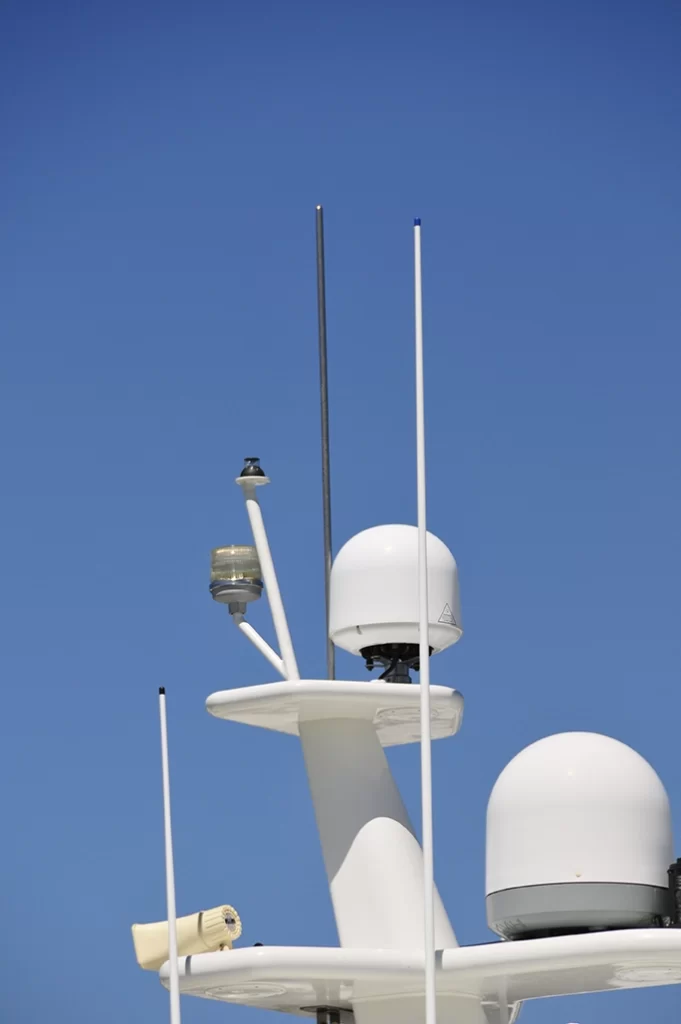
Also Read: Marine Electronics - Discover The Latest Award-Winning Products For 2023
-by steve d’antonio, fed skips, bull runs wild, hello summer after a good six months, what’s next.

Leave a Reply Cancel reply
Your email address will not be published. Required fields are marked *
Save my name, email, and website in this browser for the next time I comment.
Receive our Newsletter

Recommended
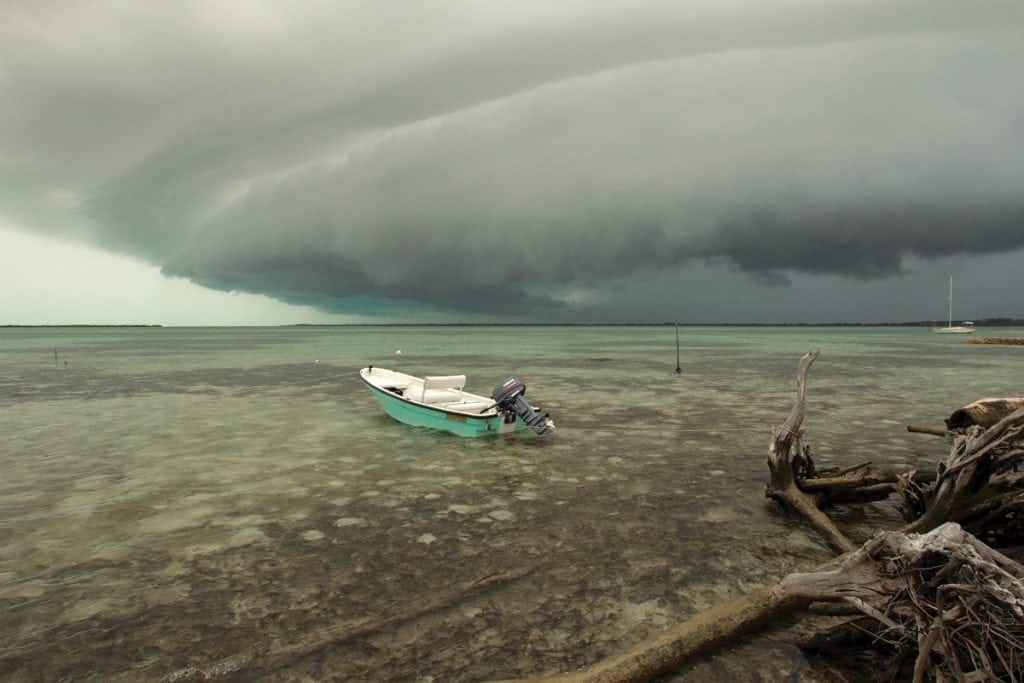
Good Advice for Bad Weather

Tarpon Springs, Florida
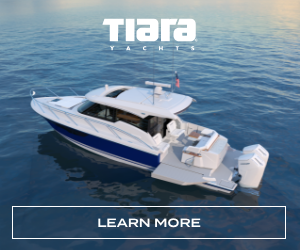
Don't miss it

End-of-Season Boat Maintenance: Winter Prep is Crucial to Ensure Peace of Mind

The Pursuit OS 405 Review: Reliable Comfort and Performance for Fishing and Cruising

We Are in the Period of Hot Air and Blue Skies

Master How To Set the Hook: Useful Techniques for Better Fishing Success

How to Catch Giant Bluefin Tuna: Fishing Tips for Success

Have You Seen Sharrow Marine’s Innovative Propeller Design? A Timely Upgrade
- Terms Of Service
- Privacy Policy

1591 E. Atlantic Blvd, 2nd Floor Pompano Beach, FL 33060 Office: +1 (954) 522-5515 Fax: +1 (954) 522-2260 Contact us: [email protected]
© 2024 Southern Boating Media
- New Sailboats
- Sailboats 21-30ft
- Sailboats 31-35ft
- Sailboats 36-40ft
- Sailboats Over 40ft
- Sailboats Under 21feet
- used_sailboats
- Apps and Computer Programs
- Communications
- Fishfinders
- Handheld Electronics
- Plotters MFDS Rradar
- Wind, Speed & Depth Instruments
- Anchoring Mooring
- Running Rigging
- Sails Canvas
- Standing Rigging
- Diesel Engines
- Off Grid Energy
- Cleaning Waxing
- DIY Projects
- Repair, Tools & Materials
- Spare Parts
- Tools & Gadgets
- Cabin Comfort
- Ventilation
- Footwear Apparel
- Foul Weather Gear
- Mailport & PS Advisor
- Inside Practical Sailor Blog
- Activate My Web Access
- Reset Password
- Customer Service

- Free Newsletter

Catalina 270 vs. The Beneteau First 265 Used Boat Match-Up

Ericson 41 Used Boat Review

Mason 33 Used Boat Review

Beneteau 311, Catalina 310 and Hunter 326 Used Boat Comparison

Tips From A First “Sail” on the ICW

Tillerpilot Tips and Safety Cautions

Best Crimpers and Strippers for Fixing Marine Electrical Connectors

Thinking Through a Solar Power Installation

Polyester vs. Nylon Rode

Getting the Most Out of Older Sails

How (Not) to Tie Your Boat to a Dock

Stopping Mainsheet Twist

Fuel Lift Pump: Easy DIY Diesel Fuel System Diagnostic and Repair

Ensuring Safe Shorepower

Sinking? Check Your Stuffing Box

The Rain Catcher’s Guide

What Do You Do With Old Fiberglass Boats?

Boat Repairs for the Technically Illiterate

Boat Maintenance for the Technically Illiterate: Part 1

Whats the Best Way to Restore Clear Plastic Windows?

Giving Bugs the Big Goodbye

Galley Gadgets for the Cruising Sailor

Those Extras you Don’t Need But Love to Have

What’s the Best Sunscreen?

UV Clothing: Is It Worth the Hype?

Preparing Yourself for Solo Sailing

How to Select Crew for a Passage or Delivery


R. Tucker Thompson Tall Ship Youth Voyage

On Watch: This 60-Year-Old Hinckley Pilot 35 is Also a Working…

On Watch: America’s Cup

On Watch: All Eyes on Europe Sail Racing

Dear Readers
- Boat Maintenance
- Systems & Propulsion
- Marine Electronics
- Safety & Seamanship
Getting the Charge Out of Lightning
No matter how well protected the boat may be, few manage to escape unscathed..
Miraculously, relatively few people are injured in lightning strikes. Frequently, of course, no one is aboard the boat when it is struck, and it is only by after-the-fact detective work that the extent of damage is discovered.
There are, however, two attendant bits of unpleasantness water, and contaminates like dirt, dust, rust, scale, bugs, and bones.
Most boat owners have only the vaguest idea of what is involved in protecting their boats from lightning damage. Many believe that their boats are already protected by the boat’s grounding system. Most are wrong.
Just because your boat may be bonded with heavy cop-per conductors connecting the masses of metal in the boat doesn’t mean that it is protected against lightning. A bon-ding system may be a part of a lightning protection system, but bonding itself offers no protection to the boat unless a good, direct path to ground is part of the system.
The purpose of bonding is to tie underwater metal masses in the boat together to reduce the possibility of galvanic corrosion caused by dissimilar metals immersed in an electrolyte. The purpose of lightning grounding is to get the massive electrical charge of a lightning strikethrough the boat to ground with the least possible amount of resistance.
Most lightning never reaches the earth: it is dispersed between clouds of different electrical potential. The lightning that concerns sailors is the discharge of electricity between a cloud and the surface of the earth, or an object on the surface of the earth, namely, your boat. The amount of electricity involved in lightning can be, well, astronomical. We’re talking about millions of volts.
Granted, the duration of a lightning strike is extremely short. But in the fraction of a second it takes for lightning to pass through your boat to ground, a great deal of damage can be done. And here’s the kicker. No matter how elaborate your lightning protection system, there is no guarantee that a lightning strike will not damage your boat.
Certainly you can reduce the potential damage from a lightning strike. That’s what protection is all about. But to think you can eliminate the possibility of damage is folly. There are too many recorded instances of so-called properly lightning-protected boats suffering damage to believe in the infallibility of lightning protection systems.
The goal of lightning protection is to offer a low resistance path to ground, in this case, the water. On a sailboat equipped with an aluminum mast and stainless steel standing rigging, the basic components of the lightning protection system are in place.
While neither aluminum nor stainless steel is an outstanding electrical conductor, the large cross-sectional area of both the mast and the rigging provide adequate conductivity for lightning protection. The trick, however, is get-ting the electricity from the mast and rigging to the water.
The straighter the path is from conductor (mast and rigging) to ground, the less likely are potentially dangerous side flashes. Put simply, side flashes are miniature lightning bolts which leap from the surface of the conductor to adjacent metal masses due to the difference in electrical potential between the charged conductor and the near by mass of metal. Ideally, therefore, the path from the bottom of the mast and rigging to ground would be absolutely vertical. In practice, this is rarely achieved.
If the boat has an external metal keel, the mast and standing rigging is frequently grounded to a keelbolt. There are pitfalls to this method. First, the connection between the bottom of the mast and rigging to the keelbolt must be highly conductive. ABYC (American Boat and Yacht Council) standards say that each primary conductor for lightning protection systems should have a resistance equal to or less than a #4 AWG copper conductor. (Secondary conductors should have resistance not greater than a #6 AWG copper conductor.)There is no drawback to using an even larger conductor.
Connecting the short conductor to the mast and keelbolt presents some problems. A crimp eye can be used on the end that is to be attached to the mast, but you may have to fabricate a larger eye for attachment to the keelbolt. This can be made from sheet copper. Soldering the connections is not recommended, since the heat generated in a lightning strike could melt the solder.
Then you have to face up to a basic problem. Your mast is aluminum, yet you’re connecting it to ground with a copper cable. Everyone knows that aluminum and copper are not galvanically compatible, so what’s the solution? While it will not eliminate corrosion, a stainless steel washer placed between the copper cable’s end fitting and the aluminum mast will at least retard it. But this connection is going to require yearly examination to make sure that a hole isn’t being eaten through the mast. In addition, of course, the process of corrosion creates wonderful aluminum oxide byproducts, which have very low conductivity. The aluminum oxide may reduce conductivity to the point where your theoretical attachment to ground is in fact non-existent. Once again, disassembling the connection and cleaning it yearly are essential to maintain conductivity. Constant attention to all the conductor connections is essential in any grounding system, whether it’s for lightning protection or grounding of the electrical system.
Even if all the connections in the system are flawless, you’re faced with getting the electrical charge out of the boat and into the water. Keels are always coated with bottom paint. Depending on the type of bottom paint used, the keel itself may be a fairly poor ground. An iron keel properly primed with epoxy mastic before bottom paint is applied is fairly well isolated from the water. If it weren’t, it would rust. The same goes for lead keels prepared in the same way. In practice, the electrical charge will probably be powerful enough to get to ground through the protection system on the keel. The same problem exists, of course, on painted metal boats with their systems of barrier coats. The barrier coats reduce conductivity, but do not eliminate it.
Do not under any circumstances ground the rigging or mast to ballast located inside a fiberglass hull shell. The electrical charge tends to travel on the surface of the conductor. Finding no path to ground from the isolated inside ballast, you may literally blow a line of holes through the hull along the top of the ballast line. Surveyors have reported occurrences of this type of damage to us, as strange as it may sound.
For boats with inside ballasting, or for powerboats, some type of external grounding plate is required. These are usually made from sintered bronze: tiny particles of bronze fused into a porous block. The effect is to give a much larger surface area than defined by the dimensions of the block itself. It is very important to use as large aground plate as necessary, and to position it as close to vertically in line with the primary lightning conductor (the mast) as possible.
Racing boats are not going to be willing to do this, since a ground plate creates a fair amount of drag in light air. Cruisers would be advised to trade off the drag for the protection offered.
A grounding plate installation is not a nail-it-in-place-and-forget-it installation. As with any bare metal underwater, oxides build up in the grounding plate, reducing its efficiency. The manufacturer of the plate can tell you the proper remedies, which may include removing the plate yearly and treating it in an acid bath to restore proper conductivity.
It is probably a poor practice to use the same grounding plate for lightning grounding and grounding of electronics such as Loran. If the lightning charge is too great for the plate to instantaneously transmit to ground, the charge may travel back through the ground wire to your electronics, with disastrous results.
For this article in its entirety please click the below link…
Getting the Charge Out of Lightning
RELATED ARTICLES MORE FROM AUTHOR

Safeguarding Sailors via Passage Guardian
Leave a reply cancel reply.
Log in to leave a comment
Latest Videos
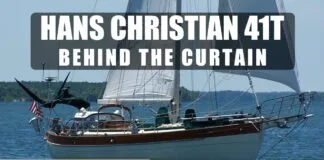
Hans Christian 41T – Boat Review

Seven dead after superyacht sinks off Sicily. Was the crew at...

What’s the Best Sailboats for Beginners?

Why Does A Sailboat Keel Fall Off?
Latest sailboat review.

- Privacy Policy
- Do Not Sell My Personal Information
- Online Account Activation
- Privacy Manager
An approach to a modern sailboat lightning protection system

We were lucky when we were struck by lightning on our small 35’ GRP cruising sailing boat in Turkey in 2013, but without an LPS. All the plastic and some of the metal gear at the top of the mast exploded (see photo below) and simultaneously the headlining in the saloon exploded downwards with a loud bang. So much smoke that we initially thought we were on fire; but my wife and I survived unscathed to tell the tale.
The most likely discharge exit was through the propeller shaft, but practically all electronics were violently destroyed and, as an electrical and electronic engineer, my assessment for our insurance claim afterwards showed that most devices had experienced severe arcing with small electronic components having exploded internally (see photo below).
An lightning protection system is a bonding, grounding and shielding arrangement made of four distinct parts: Air terminals, down conductors, a low-impedance ground system and sideflash protection.

The best lightning protection system cannot guarantee personal protection, or protection from damage to sensitive electronic equipment. Also it is not a lightning prevention system. I knew the private owner of one large blue water catamaran which has been struck three times in its life and it is not an old boat. Fortunately no one was hurt on any occasion, but many electronic systems on that complex boat were effected and had to be replaced on each occasion. Unfortunately catamarans are many times more likely to be struck than mono-hulls and records in the USA, where certain locations are particularly prone to electrical storms (e.g. Florida where boat ownership is high), show that mono-hull sailing boats are about 25 times more likely to be struck than motoryachts.
Lightning is very hard to study and to accurately predict its behaviour is almost impossible, but it is driven by the simple fact that a massive potential difference (voltage) exists between the highly charged clouds of a brewing thunderstorm and the surface of the Mother Earth. Eventually, a path is found through the atmosphere down to ground for some of the accumulated charge to discharge and the creation of a discharge path first requires the creation of so called ‘streamers’ [1],[2]. Bear in mind that air breaks down at 3 million Volts per metre, and you get some inkling of the enormous voltage differences involved.
In the middle of a large body of water, with your sailing yacht in it, the top of the mast, being the highest point around, looks like a handy point to discharge through. So the LPS is designed to control the first point of discharge and then make the onward path to ‘ground’ – in this case the sea – as direct as possible and capable of conducting very high currents for a very short time during the discharge.

In 2006, the American Boat and Yacht Council (ABYC) technical information report TE-4 [3], [4] recommended the following:-
• lightning protection system conductors must be straight and direct and capable of handling high currents. The main ‘down’ conductor is recommended to be 4AWG, or 25mm2 in European sizing; see diagram.
• A large enough area ground must be provided between the vessel and the water to offer an adequately low resistance path (ABYC recommends 1sq.ft. {0.1m2} in salt water; much larger in fresh water. NB this is not adequate for acting as the SSB counterpoise). Metal-hulled vessels naturally offer a large ground contact area with the sea, but the connection between the hull and all other electrical systems needs careful consideration.
• Heavy metal objects such as fuel tanks and engines must be bonded to the ground bonding arrangement to reduce the risk of ‘side flashing’ where the lightning literally can jump from one conductor to another, seemingly better path. Similarly, it can jump out of corners in cabling, so if bends must be made, then they should not be more than 90° and with as large a bend radius as possible.
The basic arrangement is as depicted in the diagram, where the ‘air terminal’ is a rounded end (circled in photo) metal wand mounted at the top of the mast to ‘attract’ lightning to it and, most importantly, to stand at least 6” (15cm) higher than anything else e.g. above the VHF or other antenna. Providing the air terminal is securely electrically bonded, presenting a high surface contact area, low resistance path to an aluminium mast, the mast itself can be used as the down conductor at least to the deck or keel, depending on where the mast is stepped. In the case of wooden, or carbon composite masts they present too high electrical resistance and a 4AWG cable must be run straight down the mast as the main down conductor. From the bottom of the aluminium mast or down conductor, the 4AWG onward path needs to be as direct and short as possible to the ground plate, or the metal hull.

It is actually better to leave through-hull metal fittings electrically isolated if they are already insulated from the rest of the boat by dint of their attached rubber or plastic hoses and their insulating mounting plates – decent quality bronze alloy seacocks and engine intake strainers will not unduly corrode if left submerged for extended periods of time without needing connecting to the vessel’s earth bonding. However, in the US it is more normal to bond everything metal below the waterline, use a tinned copper bus bar running the necessary length of the vessel, above any bilge water level, to connect each through-hull fitting to, which is then connected at one point only to the main grounding route out of the boat. This bonding arrangement is gaining in popularity outside the US with consideration of a lightning protection system.
Note in the diagram that all tie-ins, including fore- and back-stay (unless insulated) must use at least 6AWG (16mm2 European) cable. All large metal objects within 6ft (2m) of the lightning down path also need tying in with 6AWG (16mm2) cable. Examples are metal fuel tanks, main engines (despite them usually already being connected to the water via their prop shaft) and generators; this is to minimize the risk of ‘side flashing’ where lighting can literally jump from conductor to metal object, looking for a better path to ground, even if one does not exist.
In considering of the creation of a ground plate of sufficient size, a metal hulled vessel is ideal, but nevertheless only one electrical connection point to the hull should be made from the main 4AWG down conductor. This same point should have all the other earth bonding made to it alone. The DC main negative bus in turn should be connected to the earth bonding in only one place, though European boats generally have their DC system isolated from any bonding system to discourage DC earth faults, the US differs in this respect, preferring direct bonding. One solution to this dilemma is to use a suitably rated surge capacitor between the DC negative busbars and the bonding system for the LPS. In the case of a non-metal hulled sailing vessel, the attraction of using the keel as a discharge point should be resisted as it is in contact with the water some distance below the surface where already a lot is going on with respect to charge balancing, so an alternative point is likely to be sought out by the discharge, nearer the surface. It seemed clear to our very experienced (and ancient) marine insurance surveyor that, during our own strike in Turkey, the discharge was out through the propeller shaft.
So far, so good, but recent thinking and good practice [5],[6] has modified the above ideas to take into consideration the danger of side flashing much more. A side flash is an uncontrolled spark that carries current to the water and can do extensive damage to hulls and equipment. The good practice and standards for a lightning protection system relating to marine situations, such as they exist (see NFPA 780, latest version, especially chapter 8, ‘Protection for Watercraft’, [7]) are tending to treat a boat more and more like a building to exploit those well tried and tested techniques used in a land based situation. Rather than a ‘cone’ below the air terminal, the ‘zone of protection’ is now more reliably envisaged to be formed from a ‘rolling sphere’ of 30m radius, as shown below for a larger yacht [7],[8]:-

Diagram of Boat with Masts in Excess of 15 m (50 ft) Above the Water; Protection Based on Lightning Strike Distance of 30 m (100 ft).
With a large building, the down conductors from the various air terminals run down the outside of the building to a number of grounding stakes; not so with a yacht where, as we have described, we’ve now concentrated the discharge right in the middle of the boat, where the danger of side flashing into other metal parts is very real; if these parts are not bonded and protected by a properly designed, low impedance path there’s are very real further danger of the side flash finding its way onwards and out through the side of the boat to the surrounding water surface. This has indeed been experienced by an American friend of mine on a high-tech, all carbon racing sailing boat on its way back to Newport, which after being unavoidably struck several times in a violent storm, put in to New York and immediately hauled to find literally a thousand or more tiny holes around the waterline when the discharge had exited! Apparently lightning does not always take the straightest path to the water, but rather has an affinity for the waterline.
The latest version of this NFPA 780 standard recognises this danger and, in a departure from the older versions, provides for multiple grounding terminals to provide the shortest path to the surrounding water surface. These ‘supplemental grounding electrodes’ conduct lightning current into the water in addition to that conducted by a main ground plate. The new standard provides for a continuous conducting loop outboard of crewed areas, wiring and electronics. Placing the loop conductor well above the waterline, outboard, and with grounding terminals below it retains the advantages of an equalization bus, whilst correcting for its weakness with side flashes having nowhere else otherwise to go.

Protection of electronic equipment by a hermetic system on larger yachts
So much electronic equipment on board a yacht struck by lightning is very susceptible to permanent damage. The only safe way to fully protect electronic equipment is to have it completely disconnected from all other circuits when thunder and lightning are nearby, and I still to this day do that as much as possible, but how practical is complete protection really?
A recent idea I had whilst discussing the problem with a 30m ketch owner may have some merit, and I call it a ‘hermetic system’, so suggesting that it is sealed from the outside world: If the most critical and/or sensitive electronic equipment can be enclosed within its own quite separate power and cabling set, separate from the rest of the boat’s electrical and electronic wiring, then it is possible that it could be saved in the event of a lightning strike. One way to do this would be to run all those systems required to be protected effectively off an Uninterruptable Power Supply (UPS), powered from the AC bus (via the generator), then down converted to the necessary 24/12VDC electronics supply. In the event of a lightning storm, all AC connections to the UPS and any signals, power or ground returns outside the hermetic system must be open circuited by large clearance contactors. The electronics contained within the hermetic system can still continue to operate, for a limited time (depending on the capacity of the UPS batteries) and further choices can be made about what to shut down within the hermetic system to extend the battery life, leaving for example just the absolute minimum electronics to continue to safely navigate e.g. Depth, GPS, Chartplotter. Very careful consideration must be given to cable runs.
The VHF antenna on the main mast may be protected by a surge arrestor from one of several suppliers e.g. www.nexteklightning.com. No guarantee is likely to the effectiveness of this as a protection device in all cases of lightning strike and the manufacturers should be consulted for further information.
I certainly now resort to the marvel of a GPS chart plotter on my mobile phone when there’s a nasty electrical storm about and I’m out at sea! References: –
1. Top 10 best lightning strikes (USA) by Pecos Hank, with rare photo of an upward streamer. 2. http://marinelightning.com/index_files/SFMechanism.gif for a graphic showing the formation of negative streamers 3. ABYC (US) technical report TP-4 “Lightning Protection”. 4. Nigel Calder – “Boatowner’s Mechanical and Electrical Manual: How to Maintain, Repair, and Improve Your Boat’s Essential Systems” 5. “Complexities of Marine Lightning Protection”, By Ron Brewer, EMC/ESD Consultant, April 2011 6. “A New Concept for Lightning Protection of Boats – Protect a Boat like a Building” Ewen M. Thomson, Ph.D.; published in the October 2007 edition of Exchange 7. National Fire Protection Association (US) document NFPA 780-2014 “Standard for the Installation of Lightning Protection Systems” – see especially chapter 8 ‘Protection for Water craft’. 8. “Evaluation of Rolling Sphere Method Using Leader Potential Concept – A Case Study” P.Y. Okyere, Ph.D & *George Eduful – Proceedings of The 2006 IJME – INTERTECH Conference
Feature article written by Andy Ridyard. Andy Ridyard has been a professional electrical and electronics engineer for more than 35 years and started SeaSystems in 2008. His business is dedicated to providing troubleshooting, repair and installation services to superyachts internationally, specialising in controls and instrumentation. He lives with his wife in Falmouth, UK, but works mostly in the Mediterranean. SeaSystems has fixed countless intractable problems with marine control systems, marine electronics, Programmable Logic Controllers (PLCs) and marine electrical systems. For more information visit SeaSystems.biz .
Instagram Posts from the IIMS @iimsmarine
- Privacy Overview
- Strictly Necessary Cookies
- Performance & Marketing Cookies

This website uses cookies so that we can provide you with the best user experience possible. Cookie information is stored in your browser and performs functions such as recognising you when you return to our website and helping our team to understand which sections of the website you find most interesting and useful.
Strictly Necessary Cookie should be enabled at all times so that we can save your preferences for cookie settings.
| Name | Provider | Purpose | Expiration |
|---|---|---|---|
| wordpress_[hash] | WordPress | Used by WordPress to store your authentication details upon login and is limited to the admin area. | Just under 1 year |
| wordpress_logged_in_[hash] | WordPress | Used by WordPress to enable the interface to recognize you as a logged-in user and determine which account and preferences to use for various features. | Just under 1 year |
| wp-settings-{time}-[UID] | WordPress | Used by WordPress to facilitates customizing your view of the admin interface and the main site interface. The number UID is the individual user ID from the user database table. | 1 year |
| wordpress_test_cookie | WordPress | Used by WordPress to probe the ability of WordPress to set cookies. | 15 minutes |
| _grecaptcha | This cookie is set by Google reCAPTCHA, which protects the site against spam enquiries on contact forms. | 6 months | |
| m | Stripe | Used by Stripe Payment Services for fraud prevention and detection. | 400 days |
| __stripe_mid | Stripe | Stripe sets this cookie to process payments. | 1 year |
| __stripe_sid | Stripe | Stripe sets this cookie to process payments. | 1 year |
| wc_fragments_* | WooCommerce | Used by WooCommerce for eCommerce functionality. | 1 year |
| wc_cart_hash_* | WooCommerce | Used by WooCommerce to save items in a shopping cart. | session |
| woocommerce_items_in_cart | WooCommerce | Used by WooCommerce to save items in a shopping cart. | session |
| wp_woocommerce_session_ | WooCommerce | Used by WooCommerce for eCommerce functionality. | 2 days |
This website uses Google Analytics to collect anonymous information such as the number of visitors to the site, and the most popular pages. This also helps us optimise our marketing campaigns. User data sent to Google Analytics may be used for ad personalization and measurement of our ad campaigns. Keeping this cookie enabled helps us to improve our website.
Please enable Strictly Necessary Cookies first so that we can save your preferences!
| Name | Provider | Purpose | Expiration |
|---|---|---|---|
| _ga_* | Google Analytics | Contains a unique identifier used by Google Analytics 4 to determine that two distinct hits belong to the same user across browsing sessions. Accepting Marketing and Analytical Cookies allows us to use the data collected by this cookie for marketing and analytical purposes. | 1 year |
| _ga | Google Analytics | Contains a unique identifier used by Google Analytics 4 to determine that two distinct hits belong to the same user across browsing sessions. Accepting Marketing and Analytical Cookies allows us to use the data collected by this cookie for marketing and analytical purposes. | 2 years |
| _gid | Google Analytics | Contains a unique identifier used by Google Analytics to determine that two distinct hits belong to the same user across browsing sessions. Accepting Marketing and Analytical Cookies allows us to use the data collected by this cookie for marketing and analytical purposes. | 1 day |
| _fbp | Used by Facebook to deliver a series of advertisement products such as real time bidding from third party advertisers. | 90 days |
Yachting World
- Digital Edition

Expert sailing advice: How to handle a lightning strike on board
- August 21, 2019
Pip Hare shares advice from sailors who have experienced a lightning strike on how to avoid getting hit by an electrical storm

The 2015 Volvo Ocean Race encountered electrical storms. Credit: Brian Carlin / Team Vestas Wind
Lightning is the thing that scares me the most at sea. Having never experienced a lightning strike I think this is mostly a fear of the unknown, coupled with a sense of helplessness.
My lightning strategy has always been to sail in the opposite direction and hope for the best. The following is a combination of my own practice and observations from sailors who’ve experienced a lightning strike first-hand.
Avoiding lightning
Thunderstorms are created in conditions where there is great instability between the upper and the lower layers of the atmosphere. Typically, thunderstorms follow an extended period of warm, still weather , but lightning can also form along very active frontal systems – this tends to follow a sustained period of average pressure, with little gradient breeze when the new front moves in quickly.
Forecasters can predict where there will be increased potential for lightning to form, but not its actual occurrence or exact location.
Specialist forecast models such as the CAPE (convective available potential energy) and the LI (lifted index) show storm potential by highlighting areas of atmospheric instability.
CAPE and LI forecasts are available via specialist weather sites and CAPE GRIBs can be obtained through some providers. Satellite images can also be useful for spotting intense areas of cumulonimbus clouds.
If planning a sailing voyage in areas where lightning could be expected, include a CAPE forecast in your daily GRIB run.
Article continues below…

What is a Spanish Plume? Thunderstorms, lightning and downdrafts explained
Earlier this summer we saw considerable thunderstorm activity over the UK and Europe, resulting in flooding and some serious injuries.…

Sailing through calms: Expert advice from ocean racer Pip Hare
Psychologically, I have always found sailing through calms to be far worse than battling any storm. Endlessly flogging sails and…
Flashes on the horizon
If you get caught out or have to sail through an area where electrical storms are expected, it’s important to prepare for all the weather a thunderstorm can dish out, not just lightning.
Thunder claps can be heard for around 25 miles, so if the sky on the other side of the horizon is alive with light but you can hear no noise then stay vigilant but don’t panic – the storm is still a way off. Keep moving.
Keep a 360° look-out: due to the immense height of thunderclouds they are pushed along by upper atmosphere wind, not the sea-level breeze. This makes it difficult to predict which way a cloud is moving, they can sneak up behind you while you are sailing upwind. The best way to track thunderclouds is using the radar or a hand-bearing compass.
Prepare for a squall: wind associated with thunderclouds can reach in excess of 40-90 knots in a matter of seconds, this will often be combined with torrential rain and drastically reduced visibility. If there’s lightning around it’s best to keep on-watch crew in the cockpit so make sure you reef early.
Preparing for a strike
Lightning can strike up to ten miles away from the cloud that generated it. Just because you are in the midst of a thunderstorm doesn’t mean you will get hit – I’ve spoken to two sailors who reported lightning striking the water next to their boat but not touching them.
Others that were struck reported varying damage to electrical equipment and none experienced structural damage or fire. Here are some of their recommendations:
- Unplug all masthead units, including wind instruments and VHF antennas and ensure ends of leads are kept apart to avoid arcing.
- As the storm gets closer turn off all electronics – modern kit has increasingly efficient internal protection, but manufacturers still advise turning it off.
- Take a fix and plot it on a paper chart. Update your log using dead reckoning.
- Avoid touching metal around the boat, such as shrouds and guardrails.
- A nearby strike will be blindingly bright. Sit in the cockpit until your night vision returns.
- Expect masthead units, VHF antennas and lights to be destroyed, so make sure you carry a good quality spare VHF antenna.
- Fluxgate compasses can lose calibration following a strike. Check all electronic compass readings with a handheld compass.
Maximising protection
By providing a direct route ‘to ground’ down which the lightning may conduct you may be able to minimise damage.
Among my small sample of interviewees, only one had a lightning protection system: this was a sloop with a deck-stepped mast on which the chainplates were bonded to the keel bolts. The masthead unit on this boat was still totally destroyed by the strike but the remaining electronics suffered no ill effects. The same sailor had experienced a strike two years earlier with no extra protection installed – in that instance all electronics were destroyed.
The remaining sailors were all in boats of less than ten years old and reported varying degrees of damage to electronics and 100% destruction of masthead units.
The simplest protection system is bonding an aluminium mast to the keel bolts. On a keel-stepped mast this is easily done as the mast heel and keel bolts are close to each other. For deck-stepped masts this can be achieved by running an adequately sized cable through the deck head and down a bulkhead or supporting pillar.
Most modern boats have the mast bonded to the keel by manufacturers – if you’re not sure lift the soleboards to check. Masts made of less conductive materials such as carbon would require a conductor cable as well.
Air terminals at least six inches higher than any antennas at the top of your mast may save your masthead units. There is also considerable debate over the need for dedicated grounding plates – this appears to be more relevant to older boats as none of my interviewees suffered ill effects through grounding to the keel bolts.
Faraday cage
There is a theory that the oven on a yacht can act as a Faraday cage, protecting anything inside it from the effects of electrostatic discharge (ESD). Handheld or portable electronics can be temporarily placed inside a metal oven to protect them during a storm.
I have no conclusive evidence this works, but I’ve always done it, reckoning it can’t do any harm – just remember to take them out before dinner!
- 2024 BOAT BUYERS GUIDE
- Email Newsletters
- Boat of the Year
- 2024 Freshwater Boat and Gear Buyers Guide
- 2024 Boat Buyers Guide
- 2024 Water Sports Boat Buyers Guide
- 2024 Pontoon Boat Buyers Guide
- Cruising Boats
- Pontoon Boats
- Fishing Boats
- Personal Watercraft
- Water Sports
- Boat Walkthroughs
- What To Look For
- Watersports Favorites Spring 2022
- Boating Lab
- Boating Safety
- Ultimate Boating Giveaway

How to Prepare for Lightning Strikes
- By Ken Englert
- Updated: January 24, 2012
Lightning will always take the most direct conductive path to earth by striking the highest object in the area. Unfortunately, on the water, the highest and most attractive object to a lightning bolt just might be your boat. Be advised that when lightning strikes your boat or even near your boat, your electronics are vulnerable to damage. Here’s how to be prepared.
Create a Short Circuit There is no absolute protection against lightning aboard a boat. But there are steps you can take to avoid or minimize damage. The most likely targets are antennas, fishing rods, towers, T-tops or any elevated electrically conductive surface. You can’t prevent a lightning strike, but you can create a safe path for lightning to travel.
To conduct a strike safely to “ground” (on a boat this means to the water), create a low-resistance path from the highest point on your boat to a metal grounding plate in contact with the water. Start with a solid half-inch-diameter steel or bronze rod elevated six to 12 inches above every other object on the boat. The tip of that rod should be pointed, not blunt. Run a conductor made of at least a No. 8 gauge wire from the rod in as straight a path as possible to the water-grounding point.
The recommended water ground is a metal ground plate mounted outside of the hull. It can be copper, monel, naval bronze or other noncorrosive metal and should be solid, not the porous type used for radio antenna grounds, and be at least one square foot in area. Check with the manufacturer to see if this already exists. Also know that factory-installed lightning rods and grounding conductors are sometimes unwisely removed or disconnected by boat dealers or unknowing buyers.
Ground, Ground, Ground Ground all electronics and large metal objects on board, including metal cases or grounding studs on electronics and electrical equipment. Not to be overlooked are the engine(s), stove, sink, tanks, refrigerator, air-conditioner, metal railings, tower, arch and Bimini top. When running grounding conductors, don’t attempt to neatly bundle grounding cables together with the rest of the electrical wiring. Keep them separate from all other conductors, including antenna wires. Also, do not run the ground conductors in close proximity to or parallel to existing wire runs to prevent arcing.
More Detailed Lightning Protection Tips and Strategies
Storm Safety Tips – Lower all antennas and downriggers.
– Disconnect all power, antenna and interconnection cables to the electronics and electrical gear.
– Do not touch two metal surfaces at the same time (engine controls, a railing, helm, etc.) or you may become a convenient conducting path yourself.
– Do get out of the area and head for shore, and send the crew belowdecks.
Check out more tips on how to protect yourself and your boat during a lightning storm: 3 Crucial Tips to Avoid Lightning Strikes
- More: Electronics , Gear

Inflatable Water Mats for Boaters
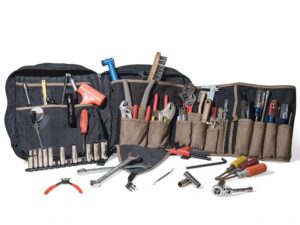
Choosing the Right Tools for Boat Repairs
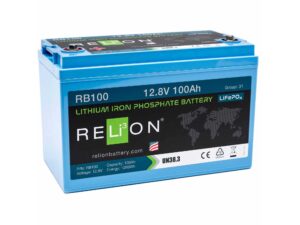
What Are the Best Trolling Motor Batteries for Your Needs?
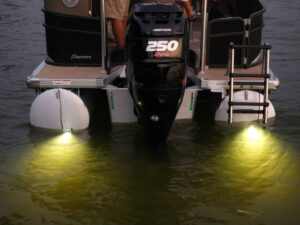
Guide to LED Pontoon Boat Lights
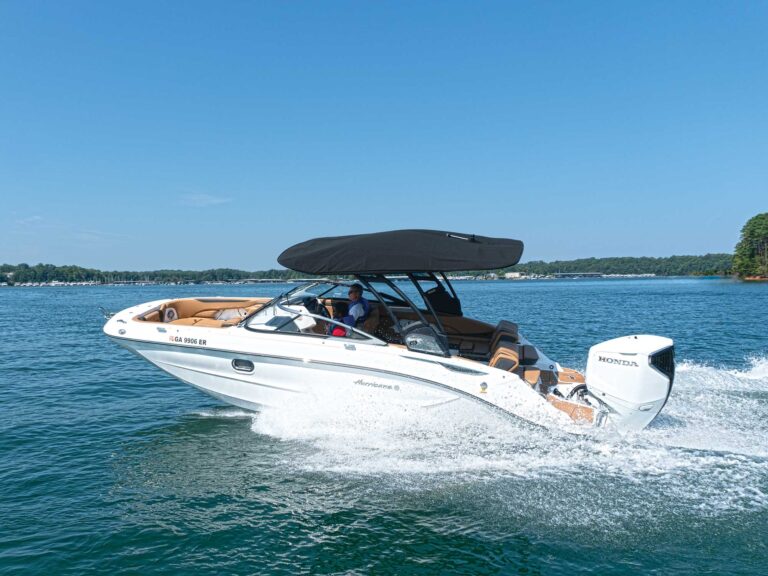
Boat Test: 2024 Hurricane SunDeck 2600 OB
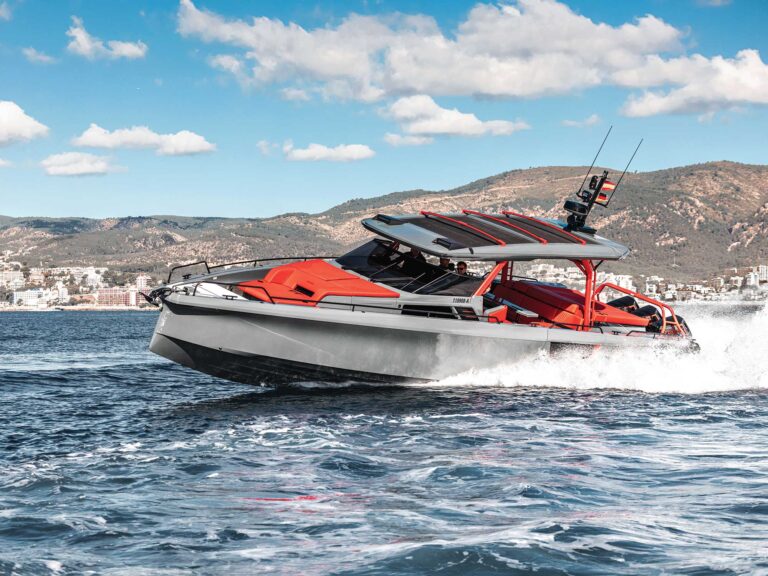
Boat Test: 2024 Brabus Shadow 1200 Sun-Top
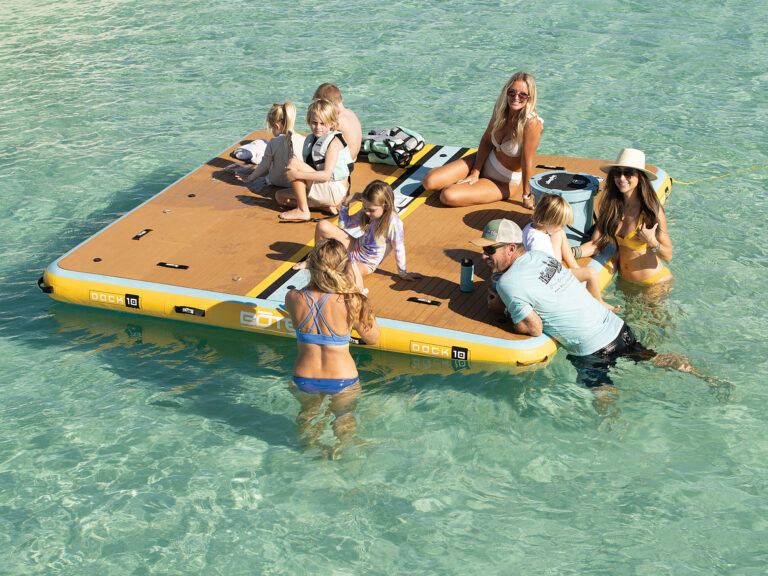
Boat Test: 2024 Monterey Elite 30

- Digital Edition
- Customer Service
- Privacy Policy
- Terms of Use
- Cruising World
- Sailing World
- Salt Water Sportsman
- Sport Fishing
- Wakeboarding
Many products featured on this site were editorially chosen. Boating may receive financial compensation for products purchased through this site.
Copyright © 2024 Boating Firecrown . All rights reserved. Reproduction in whole or in part without permission is prohibited.

NO-LIGHTNING

Protect your boat from lightning strikes.
Lightning Threat on Boats
Boats are the sharpest and highest objects on water. Depending on the size and structural properties, risk of getting hit by a lightning strike varies, but if you are the only one under thunderstorm cloud at that moment, you are most likely to experience lightning damage on your boat.
During a storm, ground charges(charges on water) accumulate on the boat, climb up to the top of the mast where wind sensors are located. As these ground charges are emitted towards the oppositely charged streamers of cloud; two charged groups meet each other and develop a conductive channel between the cloud and the mast which is called “lightning”.

All current inside cloud flows through this channel and reach to water through the mast and boat body while damaging all sensors on the mast; destroying antennas, radios, and cables; damaging batteries inside and finally breaking down the engine and causing a fire.

While discharging from the bottom, lightning current can damage the body of the boat and leave holes underneath.
Lightning Rod "Protection"
Masts are mostly made of metals such as aluminum and/or lightweight steel and they are the most conductive and highest structures on the boat. Even if you have a wooden mast, it is a high and sharp object and still conductive due to salty water particles on its surface. Masts are the primary targets of lightning strikes and must be protected against direct and indirect effects of lightning.
Lightning arresters are used to emit more charges on themselves in order to attract lightning before any surrounding object. With the use of a lightning arrester on a boat mast, the arrester collects all lightning strikes with the purpose of transferring lightning current to the grounding system safely.

However, the lightning current must reach the ground through the shortest and fastest way which is still the mast itself. Even though a conductor cable is installed between lightning arrester and grounding system, lightning current prefers to follow larger surfaces instead of a conductor cable and flows through mast surface.

Using a lightning arrester on boats does not a solution and all sensors, all electronics and engine are still damaged by lightning current and even worse; all people on the boat are under serious risk of getting hit by the lightning current.
Lightning must be kept away from boats!
EvoDis Lightning Prevention System

The point where lightning hits depends on the ground charge accumulation on a body and emission point on the top. Lightning strikes at that particular point of emission and lightning current run down to the ground through the body of the structure.

EvoDis Lightning Prevention System dissipates the ground charges on mast through thousands of tiny sharp points and blocks the emission of these charges by keeping the surrounding electric field strength below the threshold level. This process makes the protected boat “invisible” to lightning; prevents any damage on electronics and sensors and save the boat.

EvoDis Units are installed directly on the mast without a need for a conductor or any upgrades in the existing grounding system of the boat. EvoDis Units can be applied with vertical elevation rod or at the top of the mast with a flat base. EvoDis Lightning Prevention System does not require any maintenance after installation and EvoDis Units are delivered with 10-year product warranty.
EvoDis Lightning Prevention System is a lightning protection solution with 100% success in high voltage laboratory tests and in field tests. EvoDis has been applied to hundreds of lightning prone towers, masts and poles worldwide and none of these structures have been hit by lightning since the dates of installation.
Best way of lightning protection is to stay away from the lightning.
EvoDis Lightning Prevention System keeps lightning away.
You are now one step closer to be free of lightning!
Write to us.
Thank you for your interest in EvoDis Marine Series. We will contact you shortly. IMPORTANT: Please also check your SPAM folder for our feedbacks.
Hear from Us
Add your email to our Newsletter
©2023 MTO Engineering Ltd. Co. - www.mto.com.tr - All Rights Reserved

- News & Views
- Boats & Gear
- Lunacy Report
- Techniques & Tactics
MARINE LIGHTNING PROTECTION: Getting Z-Z-Z-Zapped on a Sailboat
I have to admit I don’t normally think about this too much. As is true of many sailors I suspect, I have subscribed to the philosophy that lightning and its effects are so random and poorly understood that you can get royally screwed no matter what you try to do about it. Which is a great predicate, of course, to going into denial and doing nothing at all. But the death in Florida last summer of Noah Cullen , a most promising young man who presumably was killed in a lightning strike while out singlehanding on his pocket cruiser, got me pondering this in a more deliberate manner. On doing some research, I found there are some hard facts out there that are well worth knowing.
Much of what we tend to learn about lightning is anecdotal, which mostly serves to make it seem more mysterious. I, for example, have never been struck by lightning, but I did once cut through some severe thunder squalls in the Gulf Stream in a grounded fiberglass boat and saw a bolt of lightning the size of a large tree trunk flash straight into the water just a few yards behind us. I can’t begin to tell you why it didn’t hit our nice 55-foot aluminum mast, and ever since then I’ve believed a strike is pretty much an act of God. It’s either going to get you, or not, and there’s nothing you can really do about it.
I have met a number of sailors who have been struck by lightning, mostly in grounded boats, and in every case they told me they lost all their electronics. So I have also always assumed there is nothing you can really do to protect installed electronics from a lightning strike.
But you should forget all the anecdotes you ever heard, at least temporarily, and think about the following:
Likelihood of a strike: It’s probably much higher than you like to think. One source states that a sailboat with a 50-foot mast will on average be struck once every 11.2 years. According to insurance data, the general average for all boats is about 1.2 strikes per 1,000 boats each year. The average bill for damage is around $20,000. Most strikes are on sailboats (4 strikes per 1,000 sailboats each year). And these are likely lowball numbers, as it seems many lightning-strike victims are not insured or do not report the strikes to their insurers. According to one independent survey, unreported strikes could be as high as 50 percent of the total.
Location is also a big factor. Some areas, including very popular cruising grounds like Florida or Chesapeake Bay, are much more lightning-prone than others, and you are obviously much more likely to get struck when sailing within them. The overall average for reported lightning strikes on boats in Florida, for example, is 3.3 strikes per 1,000 boats each year, nearly three times the national average.
Map showing lightning strike probabilities around the world. The higher the number, the higher the probability
Interestingly, catamarans overall apparently are struck twice as often as monohulls. Could this be because they are effectively twice as much boat???
Preventing a strike: It really isn’t possible. There is no technology that can positively keep your boat from being hit. There’s seems to be little evidence, for example, that those silly little masthead bottle brushes some people put up are good for anything.
Spectacular image of a sailboat getting hit in Rushcutter’s Bay in Sydney Harbor, Australia, with inset images showing damage to the mast. Lots of other targets with masts around, so why did the bolt hit this one boat?
Limiting damage: This is where the action is. To paraphrase one writer: it is a fallacy to think in terms of “lightning protection.” What you want is “lightning control.” Which definitely means grounding your boat! An ungrounded boat is much more likely to suffer potentially disastrous damage when struck (i.e., holes in the hull, dead crew, etc.). A boat in fresh water is also much more vulnerable, because fresh water doesn’t conduct electricity as well as salt water. An ungrounded boat in fresh water is most vulnerable of all. If you’re on one of these during a strike, you may as well just forget about it and put a cap in your head.
Typical exit damage around an anchor well drain on a fiberglass boat. Hull damage just above the waterline is not at all unusual
Grounding your boat: The old school notion of leading a big copper strip from the base of your mast in a straight line to a single grounding plate on your hull is the process of being discarded in favor of a more sophisticated technique that connects the mast as primary conductor to a network of dissipating electrodes installed just above a boat’s waterline, the idea being in effect to make all of the boat’s hull something like a Faraday cage, so that the equipment and people within will be safer.
Example of a more modern grounding system
Note (I was particularly gratified to learn this): a metal hull is indeed a great ground, and the fact that it is painted, or coated in epoxy, or whatever, doesn’t change this. But you can still suffer significant damage on a metal boat!
Bonding: You and the gear on your boat are more likely to survive a strike without damage if the major bits of metal on your boat are bonded to the grounding system. This reduces the likelihood of dangerous side flashes. (It does, however, create complications with respect to the potential for galvanic corrosion on a boat.)
Saving electronics: First of all, stowing handheld electronics (or any disconnected electronics) in your oven will protect them during a strike. Just remember to take them out again before using the oven!
More importantly, you can protect installed electronics using various individual surge protectors, fancy spiral wiring, and other techniques I’m not going to pretend to understand, much less explain. See the sources below for more details.
Your personal safety: This should be most important, right? You want to stay off the helm if possible, stay below, stay dry, and don’t touch any big pieces of metal. All of which are easier said than done when you’re in the middle of a big squall! It would seem the most prudent tactic is severely reduce sail, or take it all down, pop the boat on autopilot, and get below well in advance of and after a thunderstorm.
Lightning and Sailboats : Academic paper published by Ewen M. Thomson, currently recognized as the most well-informed go-to guy on this subject.
Marine Lightning Protection : Website for a business run by Ewen Thomson (see above), who is a pioneer in modern cage-style boat-grounding techniques. Thomson will ground and bond your boat for you, if you like, but there’s also lots of useful raw info in here.
Lightning Survey Results : Discussion re results of a small independent online lightning-strike survey conducted by a cruiser who owns a power-cat named Domino . Very informative.
Considerations for Lightning Protection : Conclusions reached post-survey by the owner of Domino , referenced above.
Lessons in Lightning : Ocean Navigator article by a cruiser in an aluminum boat who was struck by lightning in the Baltic. Of particular interest to those (like myself) who own aluminum boats.
There are lots of other resources out there, but these four links are a very good place to start. You’ll find many other valuable sources just by reading through these articles and following the links within.
Related Posts

STORM PORN: Casco Bay Thunder Squall
We were hit by lightning in a fast moving front off Newfoundland many years ago (before gps). All the electronics were fried! The binnacle must have been demagnetized as it hopelessly spun in circles, giving us only a hand sighting compass to steer by. The smell of burned wire insulation in boat was overpowering. Luckily this is a rare occurrence and for the most part just bad luck!
@Robert: Interesting. In Bermuda once I met a tall ship, steel hull, that had been struck by lightning, and as a result the whole ship was magnetized. Which also kept their compasses from working properly. They were on their way to Norfolk, Virginia, to get degaussed.
I feel obligated to take issue with a fair bit of what’s been said above. Without writing a textbook, the following is best seen as “almost correct”. If you consider that the sky has a positive electrical charge and the sea a negative charge, grounding the boat and the mast gives them a negative charge. Hence as far as the lightning is concerned, the bonded mast raised the local sea level to mast top height. Lightning will tend to bridge the narrowest gap with the greatest electrical charge difference – so by grounding boat and mast, you have made them MORE vulnerable to lightning strikes, not less. In other words, NOT grounding the boat and mast will REDUCE your chances of being struck.
Tying an earth system into the keel bolts is not likely to result in loss of the keel, but it sure does constitute trying your best to do so. If the bolts are electrically weak they may act as a fuse and “blow” during a strike.
Making a Faraday shield form shown above does help mitigate the effects of the strike compared to a simple bonding of the mast to the keel in many situations, but it’s over-rated. In a big strike, lightning will try to follow a straight path and the energy contained in such a strike is often too great for a simple system to be effective. And it needs to be understood that either method makes the strike a whole lot more likely to occur.
A grounded mast does offer a degree of protection to a non-bonded electrical system in the boat underneath. There is what’s termed a “cone of protection” extending downwards at 30 degrees from the top of the mast. This is the standard system used in telecommunications.
The best protection you can have is to park your ungrounded wooden boat with a wooden mast and an electrical system isolated from the sea, right next to a grounded metal boat with a big aluminium mast. In the photo above depicting the Sydney harbour yacht being struck, the question was posed “why did the bolt hit this one?” The answer is that it was best grounded boat in that area.
@Bryan Tuffnell while part of what you say is true that a grounded boat is more likely to be struck the catch is that it will do less damage if struck where as a boat not grounded is less likely to be struck if it ever is you will have significantly more damage
Maybe, but quite likely not. The only way to offer lightning protection is to place a grounded lightning target above the mast, but electrically isolated from the mast and every other part of the boat. The grounding is completely independent of the mast, rigging, interior, electrical system, and above waterline areas of the hull. The idea is that this attracts the lightning and provides a low impedance path to ground, without drawing the charge into any part of the boat or its contents. Using this strategy one does not ground the mast, hull, rigging, etc. This is the only strategy to apply if one insists on lightning protection.
the sky has a positive electrical charge and the sea a negative charge
Its the other way round. When polarity builds up the negative charge is at the cloud base, and the positive at the sea surface. [quote=Bryan TuffnellNOT grounding the boat and mast will REDUCE your chances of being struck[/quote] Wrong – the enormous voltage actually doesn’t care if you’re grounded or not. Given the fact that the boats surface will always be wet or moist in some way it is “grounding” enough to raise the sea level polarity up to the mast top. The only thing proper grounding does is trying to guide the current of a charge in a way that does the least harm.
Not necessarily in the first case, and generally not true in the second… the polarity of lightning is variable, and there are countless examples of nearby strikes to ungrounded boats. Obviously if lightning didn’t care of you were grounded or not, lightning conductors wouldn’t work.
As far as doing the least harm goes, grounding the mast is about the worst thing you can do, particularly if you have grounded electrical items onboard.
Our boat (20′ cruiser) has no grounding system. Is it foolish to think that the method where a set of jumper cables is attached to mast and other end dropped overboard, might be a good emergency strategy if caught in elec storm?
what a topic indeed. to protect or not to protect, that is the question. simply do you use a brush type or spike type diffuser on your mast, do you protect for side strikes, or stay central with mast bonding.. im trying to find an answer like us all and so far , the answers all differ..
Leave a Reply Cancel Reply
Save my name, email, and website in this browser for the next time I comment.
Please enable the javascript to submit this form

Recent Posts
- BAYESIAN TRAGEDY: An Evil Revenge Plot or Divine Justice???
- MAINTENANCE & SUCH: July 4 Maine Coast Mini-Cruz
- SAILGP 2024 NEW YORK: Lifestyles of the Rich and Famous
- MAPTATTOO NAV TABLET: Heavy-Duty All-Weather Cockpit Plotter
- DEAD GUY: Bill Butler
Recent Comments
- Alvermann on The Legend of Plumbelly
- Charles Doane on BAYESIAN TRAGEDY: An Evil Revenge Plot or Divine Justice???
- Nick on BAYESIAN TRAGEDY: An Evil Revenge Plot or Divine Justice???
- jim on BAYESIAN TRAGEDY: An Evil Revenge Plot or Divine Justice???
- Fred Fletcher on TIN CANOES & OTHER MADNESS: The Genius of Robb White
- August 2024
- January 2024
- December 2023
- November 2023
- October 2023
- September 2023
- August 2023
- February 2023
- January 2023
- December 2022
- November 2022
- September 2022
- August 2022
- February 2022
- January 2022
- December 2021
- November 2021
- October 2021
- September 2021
- February 2021
- January 2021
- December 2020
- November 2020
- October 2020
- September 2020
- August 2020
- February 2020
- January 2020
- December 2019
- November 2019
- October 2019
- September 2019
- August 2019
- January 2019
- December 2018
- November 2018
- October 2018
- September 2018
- August 2018
- February 2018
- January 2018
- December 2017
- November 2017
- October 2017
- September 2017
- August 2017
- February 2017
- January 2017
- December 2016
- November 2016
- October 2016
- September 2016
- August 2016
- February 2016
- January 2016
- December 2015
- November 2015
- October 2015
- September 2015
- August 2015
- February 2015
- January 2015
- December 2014
- November 2014
- October 2014
- September 2014
- August 2014
- February 2014
- January 2014
- December 2013
- November 2013
- October 2013
- September 2013
- August 2013
- February 2013
- January 2013
- December 2012
- November 2012
- October 2012
- September 2012
- August 2012
- February 2012
- January 2012
- December 2011
- November 2011
- October 2011
- September 2011
- August 2011
- February 2011
- January 2011
- December 2010
- November 2010
- October 2010
- September 2010
- August 2010
- February 2010
- January 2010
- December 2009
- October 2009
- Boats & Gear
- News & Views
- Techniques & Tactics
- The Lunacy Report
- Uncategorized
- Unsorted comments

Please verify you are a human
Access to this page has been denied because we believe you are using automation tools to browse the website.
This may happen as a result of the following:
- Javascript is disabled or blocked by an extension (ad blockers for example)
- Your browser does not support cookies
Please make sure that Javascript and cookies are enabled on your browser and that you are not blocking them from loading.
Reference ID: ec97116a-6be8-11ef-ad34-136633045344
Powered by PerimeterX , Inc.
- Commercial shipping
- Recreational boating
- Authorities
- Lightning Protection
- GMDSS equipment
- Service & maintenance
- ferropilot.de

- Yacht Lightning Protection DDCE Marine
The complete lightning protection for sailing yachts and motor boats. The core of our lightning protection is the DDCE inhibitor system from Dinnteco. This innovative system protects your yacht against direct lightning strikes. In addition we offer further protection against indirect strikes from the water and for the shore connection.
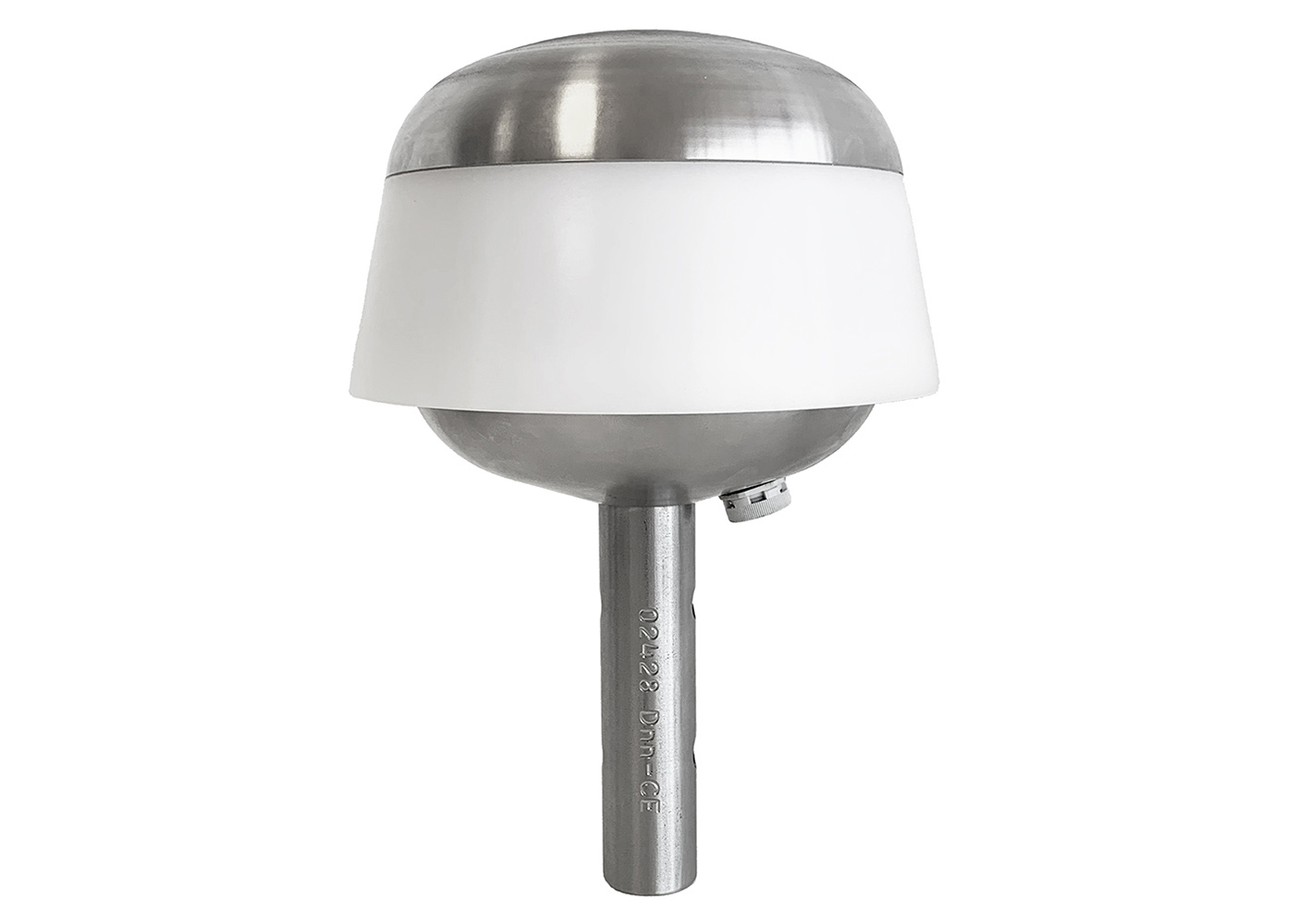
DDCE Marine Lightning Protection
The innovative DDCE lightning protection system prevents the forming of lightning strikes in the protected area. The system is approved on land since many years with amazing results. The Marine DDCE is explicitly designed for the requirements and harsh conditions at sea .
More and more Sailing Yachts and Motorboats trust in the DDCE system. Several famous Yachts from Baltic Yachts, Royal Huisman and Nautor Swan installed the System with sucess.
Application Areas
The manufacturer Dinnteco has been installing this technology on buildings, sensitive industrial plants, historical facilities and any buildings that need to be protected from lightning for more than 20 years. More than 8.000 units has been installed.
In the past the marine market was not the focus of attention which is now reflected by the extra developed Marine DDCE.

Holger Flindt, Head of Claims Department of Pantaenius (Europe’s leading specialist for yacht insurance) is convinced of the DDCE System: “Damage caused by lightning is increasing. In recent years the number corresponding events at Pantaenius tripled. Although the effects of a direct or indirect lightning strike can vary greatly, they often mean considerable danger for man and material. Even days after an unnoticed lightning strike it happens that boats suddenly sink at the pier. Whether and how a boat survives a thunderstorm is not only a question of luck. A properly installed lightning protection system such as the DDCE system protects people and material.
The DDCE system is therefore supported by us and a compliant protective measure for us. And it also exempts the customer from an excess in the event of a lightning strike in particularly endangered shipping areas.
Forming of Lightning strikes
During a thunderstorm, a potential difference is created between the clouds, which are usually negatively charged in a thunderstorm, and the positively charged earth. At certain points, this can lead to an increase in charge concentrations. In these strong electrical voltage fields between clouds and earth, lightning finally discharges.
In the process, negative charge carriers first migrate towards the ground in the so-called conductive lightning and prepare an ionised channel through which the current can finally flow. At the same time, the ground under the thunderstorm becomes positively charged. At exposed locations such as church steeples – or the masts of sailing yachts or equipment carriers of motor yachts – the electric field is particularly large. From such places, a positive charge – also called an upward streamer – can go towards the leading lightning and closes the lightning channel so that the main discharge can follow.
This usually consists of several individual discharges and can reach a current strength of 100,000 amperes.
Functionality of DDCE System
The DDCE (Electromagnetic Charge Compensation Device) is a System of Protection against Atmospheric Discharges and an Electromagnetic Protector that avoids the impact of the lightning strike on the protected structure.
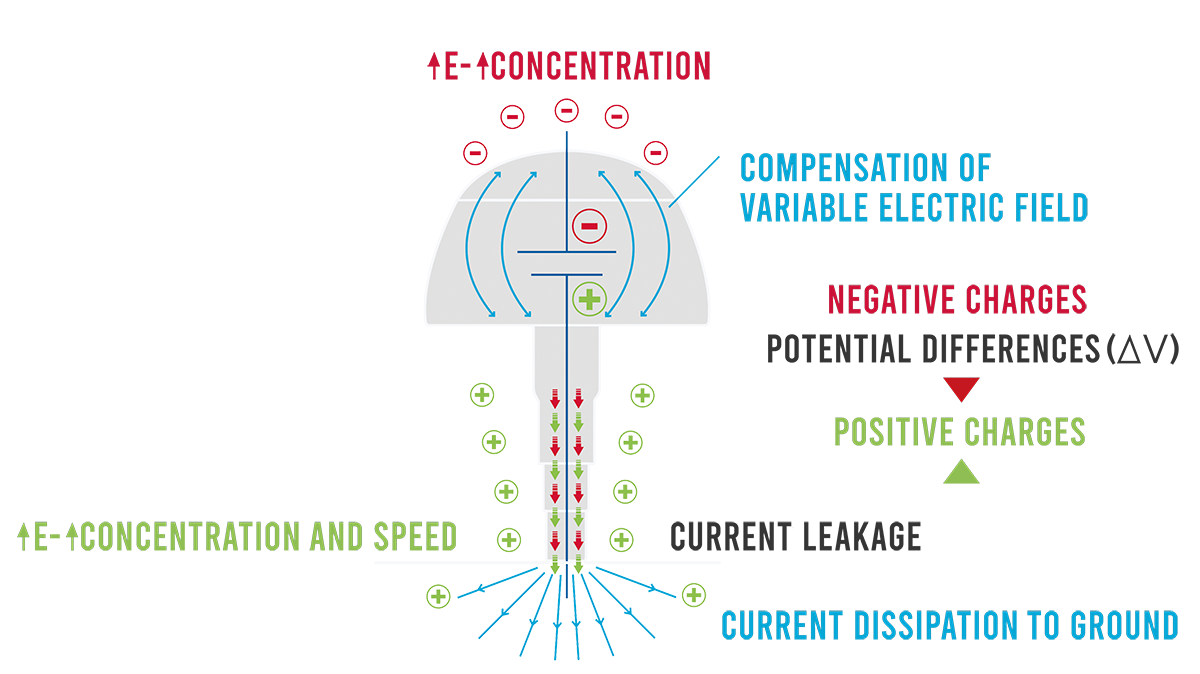
How does the DDCE work?
The DDCE system from Dinnteco provides potential equalisation so that in the protected area no lightning will be formed. The DDCE attracts excess negative charges from the air layer, compensate and drain it through the grounding. This process eliminates positively charged upward streamer from the protected structrure and thus prevents the formation of a flash channel or stepped leader and avoid the main discharge (lightning strike) into the yacht.
By varying the electric field in its environment a leakage current is generated whic will be drained to ground. The DDCE is a passive device and needs only a sufficient grounding and no power supply.
It should be noted that thunderstorms are a weather phenomenon that is always difficult to calculate, and no lightning protection system can provide 100% safety. The risks must always be evaluated individually.
Marine Specialties
The biggest difference between lightning protection on ships and on land are the space and the distances. On land, lightning strikes can often be dissipated with little damage.
At sea, the situation is quite different. Due to the limited space, the necessary distances between the arresters cannot be maintained. It often comes to flashovers or inductions which has a considerable damage to the yacht and especially the electronics. This makes the DDCE system especially in the marine market so unique.
Of course, you must be aware that no lightning protection system in this world can give 100% protection.
Protection against indirect strikes
For the eventuality that the lightning strike will hit the water outside the protected area, a sufficient protection against electromagnetic impulses (EMP) is recommended.
A lightning flash generates an electromagnetic field which induces over-voltages of significant magnitudes on structures in the vicinity. For the electronic equipment are these EMP’s just as dangerous as direct strikes. The harmful EMP can move hundreds of meters and enters the inside of the boat through conductive parts in the hull.
To protect the electronic equipment from EMP’s we recommend to install a DINFIL ground filter which reduces the high frequencies. The remaining low frequencies will be discharged to ground by a Surge protector (SPD).
Shore Power Protection
The third step to a complete lightning protection is the security against indirect lightning strikes from the harbour over the shore power connection. We provide you with the suitable protection according your needs.
ELNA Lightning protection DDCE Flyer.pdf
DDCE MARINE LT technical brochure_web.pdf
For any questions, callback requests or request for quotation please use the adjacent contact form. We are looking forward to hearing from you!
Address (street, postal code, city, country)*:
E-mail address*:
Your message:
Related products
Search and rescue solutions.
Ideal communication solutions for a fast rescue in emergency situations.
Fire detection and alarm systems
Effective protection by Marinelec and Autronica for vessels of all sizes.
Wiper systems and components for marine applications by Hepworth & Wynn
Electrical components
Electrical components in outstanding marine quality by Blue Sea Systems.
Nine’s Wide World of Sports
'You get a shock': Lightning strike ends America's Cup racing as Team New Zealand takes boat off course
- This article originally appeared on Stuff and is reproduced with permission
A lightning strike on the race course prompted an abrupt end to racing at the America's Cup but not before the Swiss scored a vital victory over the French.
Team New Zealand skipper Peter Burling said "holy shit" as the lightning fork struck the water and that "it's not worth it", taking his boat off the race course while trailing Luna Rossa on day five of the challenger series in Barcelona on Wednesday (AEST).
DAY 6 WRAP: Aussie's golden lap, Rollers devastation
READ MORE: 'Devastation' as leader falls metres from finish line
READ MORE: Dragons desperate to offload star after 'shocker'
Officials quickly ended the day due to the risk to the carbon fibre mast, boats, electronics and crew, of a direct strike.
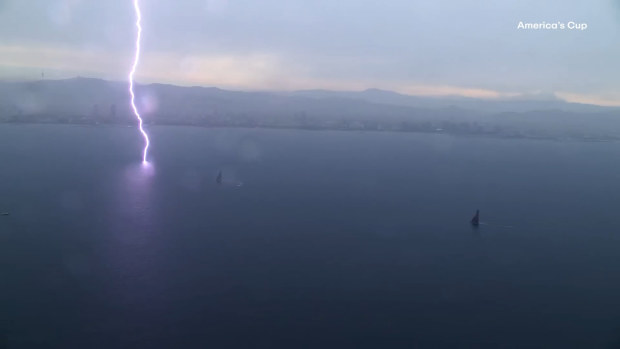
Racing had to be abandoned after fork lightning dramatically struck during Race 17 of the Louis Vuitton Cup Round Robin sailing in Barcelona. America's Cup
"I think in general, the people would be okay, but the carbon structure gets hurt, the mast would be in really bad shape, and all the electronics," Team New Zealand skipper Peter Burling said.
Burling withdrew their boat racing with Luna Rossa and headed for where some large superyachts were in the spectator fleet.
"They're set up to be hit by lightning, where for us, we've only got two little foils in the water, so we're not. So our plan was to try and get next to something that's taller than us."
Australian Jimmy Spithill, one of the co-helms aboard Luna Rossa, said he's been struck by lightning before, which is not an uncommon experience in sailing.
"I actually felt OK because I've been struck by lightning twice before," he said. "They say when you've been hit before your odds of getting hit again are way smaller. So I reckon we were the safest boat in the fleet.
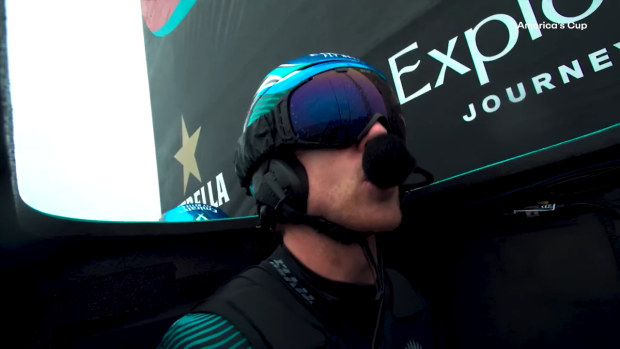
Team New Zealand skipper Peter Burling was caught off guard by the loud booms. America's Cup
"It would have been catastrophic for the boat, though, no question. Both times I've been hit it destroyed the boat. The first time the boat actually caught fire because it was wooden and it hit the rig.
"I felt the lightning through my body. You get a shock but it's like your eardrums get blown up."
INEOS Britannia was preparing for its race, and helmsman Dylan Fletcher said he'd seen a few lightning strikes, and they were a safety risk as carbon fibre is a conductor.
"We're on a carbon fibre boat with carbon fibre masts and carbon fibre shrouds and for the helmsmen or the trimmers and the others, our heads are right next to those those shrouds," he said.
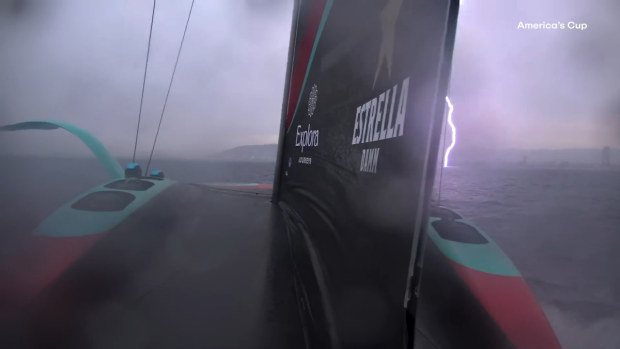
Team New Zealand had to take their boat off course. America's Cup
"If you get struck by lightning it's probably campaign-ending which no one wants for any of the teams around here."
Team New Zealand's dash for safety saw them disqualified from a race they were losing, after a mistake at the start let Luna Rossa get the jump and build a big lead.
"It was a great sign of strength. But at the same time, a little bit frustrating because we made some errors out there that we really need to stop," said Spithill.
Burling said: "We're just happy to have the boat back in one piece."
In the opening race, Alinghi Red Bull Racing scored their first win – a point which has reduced their chance of being the team eliminated at the end of the knockout series.
But the Swiss crew gave supporters a heart-stopping moment, going off the foils in the pre-start.
"Two-thirds of the chase boat that I was on said, no, not again, come on. And then one-third said, no, no, no, they're going, they're going," said the general manager Silvio Arrivabene.
The Swiss narrowly got the jump on France's Orient Express, which had one point, but the French boat went off its foils, falling to a 183m deficit from which it never recovered, and was beaten by 1min 10sec. Arrivabene saw that first win as a turning point.

Australian Jimmy Spithill, one of the co-helms aboard Luna Rossa. America's Cup
"I think that turning point may have started a couple of days ago with the Luna Rossa race, where we finally were able to manage to start and get off the line with good speed, and be in the race all along," he said.
For Orient Express, a win over the Swiss would have given them a two-point buffer above the elimination slot, and skipper Quentin Delapierre felt they were unlucky.
"Some of the electronics were not working as we wished, it is what it is, this is the Cup and it's part of the game, so we just have to manage and move forward," he said.
If the teams remain tied on one point by Monday (NZ time), a brutal one-race sail-off will decide which goes home, not something Delapierre is dwelling on at the moment.
"We are definitely able to win another match, or even two, against the other teams, so that's where I'm really focused now, just winning more matches this week," he said.
Stormy weather is forecast again for day six (Thursday Australian time) with a risk of further disruption, meaning the regatta might use "reserve days" on Friday and Saturday (Australian time) for any postponed races.
Luna Rossa leads the challenger table with four points, from five races, while INEOS Britannia has three points from four, and American Magic two points from four starts, with Alinghi RBR and Orient Express tied on one point from five starts.
- America's Cup
Most viewed in Sport

Pole vault freak stuns athletics world with sizzling 100m time

Players 'can't leave hotel' ahead of historic clash

'You get a shock': Aussie's close call as lightning halts America's Cup

Star hockey player dies in 'devastating' tragedy
‘Holy s***’: Aussie sailor’s terrifying close call after lightning storm forces race to be abandoned
Australian Jimmy Spithill was caught up in a terrifying lightning strike that halted action during Race 17 of the Louis Vuitton Cup Round Robin in Barcelona.
Spithill was one of the co-helms aboard Italy’s Luna Rossa, who made a strong start to take a 400m lead over Emirates Team New Zealand and looked to be in a comfortable position entering the final leg — until lightning dramatically changed that equation.
Racing was abandoned for the day after the strike, which took place around 200m in front of the Italians, with the New Zealand crew watching on in shock from behind.
Every race of the 2024 Louis Vuitton Cup live in 4K. Available on Kayo. New to Kayo? Start Your Free Trial Today >
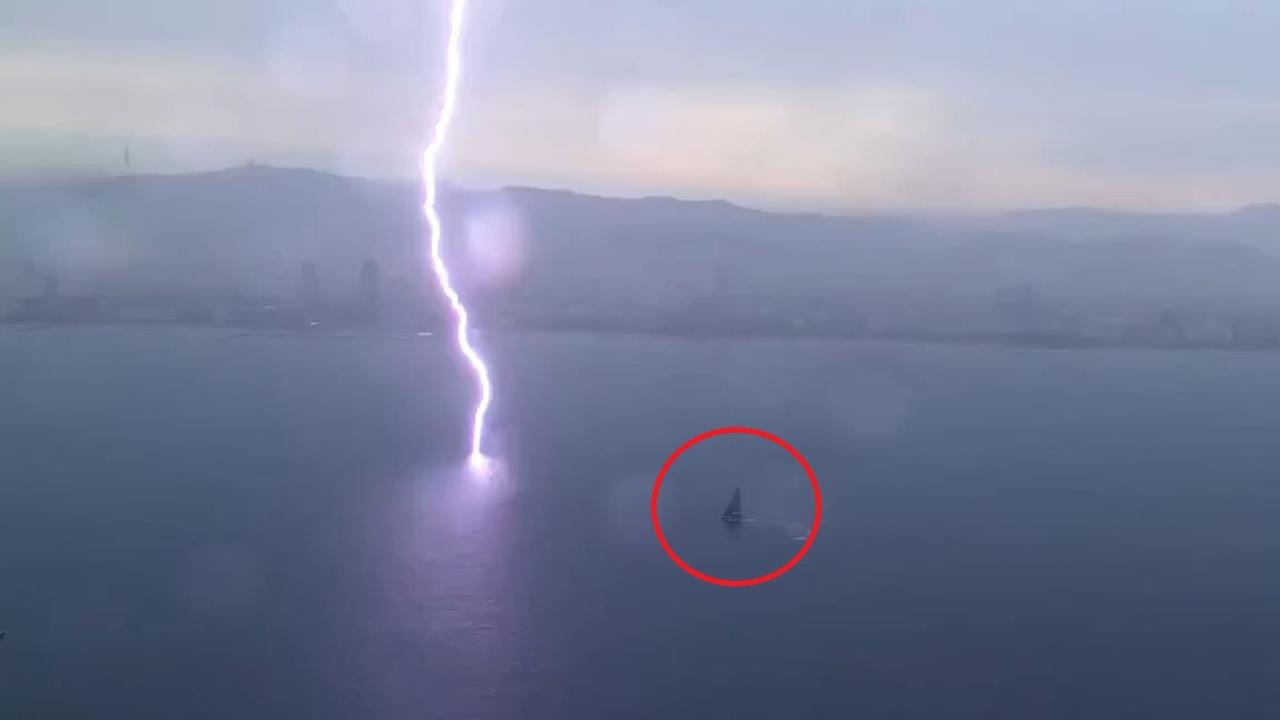
Vision captured sailors on the New Zealand boat reacting to the strike in real time, with expletives aplenty as one was heard exclaiming “holy s***”. “F*** me,” said another.
The lighting strike sent the New Zealand team for cover off the course, with the Race Committee later awarding the race win to Luna Rossa and disqualifying the Kiwis for going outside the boundary.
It turns out Spithill wasn’t too concerned though, with the Australian later revealing that he has already had a few run-ins with mother nature in the past.
“I actually felt OK because I’ve been struck by lightning twice before,” he told The Telegraph UK .
“They say when you’ve been hit before your odds of getting hit again are way smaller. So I reckon we were the safest boat in the fleet.
“It would have been catastrophic for the boat, though, no question. Both times I’ve been hit it destroyed the boat. The first time the boat actually caught fire because it was wooden and it hit the rig.
“I felt the lightning through my body. You get a shock but it’s like your eardrums get blown up.”
The Louis Vuitton Cup determines the challenger to face New Zealand in the America’s Cup proper in October, starting with two rounds of matches before a semi-final and final.
New Zealand will be involved in the group stage of racing but not the knock-out rounds and this is their final chance to finesse their approach.

Incredible moment yacht narrowly avoids being struck by lightning in America's Cup electrical storm: 'I felt the lightning through my body'
- Lightning strike brought an end to day five of the challenger series
- Aussie sailor Jimmy Spithill was on the yacht during storm
An Australian sailor has spoken about a dramatic lightning strike on day five of the Louis Vuitton Cup challenger series, revealing that he felt the lightning through his body.
Racing had to be called off when Team New Zealand and Luna Rossa narrowly avoided lightning strikes on the water in Barcelona .
The Italians were leading the Kiwis when fork lightning hit the water just 200 metres in front of the Italians.
The strike prompted some colourful language from the New Zealand sailors who quickly decided to avoid the storm.
Aussie sailor, Jimmy Spithill, skipper of Luna Rossa, wasn't put off by the storm.
'I actually felt OK because I've been struck by lightning twice before,' he told The Telegraph .
'They say when you've been hit before your odds of getting hit again are way smaller. So I reckon we were the safest boat in the fleet.
'It would have been catastrophic for the boat, though, no question. Both times I've been hit it destroyed the boat. The first time the boat actually caught fire because it was wooden and it hit the rig.
'I felt the lightning through my body. You get a shock but it's like your eardrums get blown up.'
Kiwi helmsman Peter Burling, who has also been on boats struck by lightning before, said he wasn't taking any chances.
'I got a pretty good view of it,' Burling said.
'The amount of damage [to the boat] if you do get hit is just crazy,' Burling said.
'For us it was about making sure we could get near to something tall to look after the boat.'
Kiwi trimmer Andy Maloney said it was the right decision to make.
'You never want to be out there when you start seeing lightning bolts that close to the race course,' Maloney said.
'It is pretty scary. I think we did the right thing, getting out of there as soon as we could, getting our sails down and getting close to some tall superyacht rigs.
'It would destroy the boat. All the electronics were stuffed when it happened in SailGP.'

Navigation for News Categories
America's cup: racing postponed after lightning strikes.

General views of the America's Cup defender Emirates Team New Zealand headquarters Photo: PHOTOSPORT
There was no racing on the scheduled sixth day of the America's Cup challenger series off Barcelona because of stormy weather.
Wednesday's (NZ time) racing was cut short because of an electrical storm, and it was a similar situation on Thursday.
The beginning of September is very much a transition period in the weather, so Mediterranean storms are commonplace. With winds reportedly gusting up to 50 knots and a front heading towards Barcelona, the Race Committee made the call to abandon all racing.
Team New Zealand, competing in the round-robin part of the series, were scheduled to race Britannia of Great Britain and Orient Express of France.
On Wednesday there was a dramatic lightning strike just a few hundred metres ahead of the Luna Rossa and Team New Zealand on the final leg of their race and headed to the finish.
That race was abandoned immediately, and the AC75s - with full carbon masts and hulls - headed initially into the spectator fleet before fast-towing back to their bases in the Port Vell.
In addition to the cancellation of racing at the Louis Vuitton Cup, the decision was also taken to close the official race village on the Moll de la Fusta and all fanzones due to the forecast for heavy rain, squalls and the possibility of thunder and lightning around the Barcelona area.
Race director Iain Murray issued his intention to hold five races tomorrow, but has shuffled the order of the race schedule to ensure that competitors sail no more than two races in a day and that competitors do not sail in two consecutive races.
Murray expected the winds to shift round more southerly in the coming days to produce a good racing breeze of around eight to 12 knots.
Copyright © 2024 , Radio New Zealand
Related Stories
America's cup: patched-up team nz coast to victory in return to racing.

After dropping the boat on Thursday, the Kiwi shore crew worked round the clock to get it back onto the Mediterranean, missing only one day of racing.
Team New Zealand win America's Cup warmup regatta

Team New Zealand won the preliminary regatta off Barcelona overcoming their closest race of the series to clinch the title.
Lightning halts sailing at America's Cup

Lightning during an America's Cup qualifying contest between defenders New Zealand and the in-form Italians prompted officials to abandon racing off Barcelona for the day. Video
- Chess: Arch-rivals to finally square off after acrimonious legal spat
- All Blacks v South Africa: Scott Robertson rolls the dice
- Ugandan athlete Rebecca Cheptegei dies, days after boyfriend set her on fire
Get the RNZ app
for ad-free news and current affairs

Top News stories
- Auckland apartment sells for $1m less than it was bought for
- Kuini Nga wai hono i te po needs to carry kotahitanga forward, advisor says
- A last minute amendment to NZ’s gang legislation risks making a bad law worse
We have regular online commentary of local and international sport.
Follow RNZ News

IMAGES
VIDEO
COMMENTS
A lightning protection system (LPS) is designed to divert lightning energy to ground (in this case the sea), in such a way that no damage occurs to the boat or to people. Ideally, this also includes protecting a boat's electrical and electronic systems, but marine electronics are sensitive and this level of protection is hard to achieve.
Most boats are built in compliance with the safety grounding and lightning protection recommendations of the American Boat and Yacht Council (ABYC). The highest mast will be well grounded to the sea through a copper wire of suitable size, which connects to a metal plate mounted on the hulls exterior surface.
While the recommendations in NFPA 780 have yet to be embraced by the recreational boating industry as a whole, understanding what it says — and why — may assist you in developing a lightning-protection plan for your boat. Lightning 101. The simplest way to think of a lightning strike would be as a short circuit between the cloud and the earth.
Plumbing, electrics — all come under their purview. The ABYC suggests that the best way to protect a vessel from a lightning strike manuals suggest installing a lightning mast at least one-third the length of the boat in height above the boat, forming what it calls a 60-degree cone of protection.
The American Boat and Yacht Council's (ABYC) Standards, Chapter TE-4 "Lightning Protection" spells out guidelines that are primarily designed to keep those aboard safe from injury and fire caused by lightning strikes. To be clear, this system does not prevent lightning strikes (whether or not any system is capable of doing that is hotly ...
Arne Gründel of Sertec explains: "The CMCE system prevents a lightning strike by attracting and grounding excess negative charges from the atmosphere within the cover radius of the device. This ...
The goal of lightning protection is to offer a low resistance path to ground, in this case, the water. On a sailboat equipped with an aluminum mast and stainless steel standing rigging, the basic components of the lightning protection system are in place. While neither aluminum nor stainless steel is an outstanding electrical conductor, the ...
In 2006, the American Boat and Yacht Council (ABYC) technical information report TE-4 [3], [4] recommended the following:-. • lightning protection system conductors must be straight and direct and capable of handling high currents. The main 'down' conductor is recommended to be 4AWG, or 25mm2 in European sizing; see diagram.
Take a fix and plot it on a paper chart. Update your log using dead reckoning. Avoid touching metal around the boat, such as shrouds and guardrails. A nearby strike will be blindingly bright. Sit ...
There is no absolute protection against lightning aboard a boat. But there are steps you can take to avoid or minimize damage. The most likely targets are antennas, fishing rods, towers, T-tops or any elevated electrically conductive surface. You can't prevent a lightning strike, but you can create a safe path for lightning to travel.
Lightning Strike! Protect Your Sailboat Part 1 Revised. Learn here, how to protect your sailing vessel, 20 - 30 feet in length, day sailors, racers and coas...
Practical Lightning Protection. The American Boat and Yacht Council (ABYC) recommends installing a lightning mast above the boat to create a "60-degree cone of protection." However, maintaining a straight path to the waterline and keeping a grounding plate submerged at speed can be challenging. Laying antennas flat, raising Bimini tops or ...
EvoDis Lightning Prevention System dissipates the ground charges on mast through thousands of tiny sharp points and blocks the emission of these charges by keeping the surrounding electric field strength below the threshold level. This process makes the protected boat "invisible" to lightning; prevents any damage on electronics and sensors ...
One source states that a sailboat with a 50-foot mast will on average be struck once every 11.2 years. According to insurance data, the general average for all boats is about 1.2 strikes per 1,000 boats each year. The average bill for damage is around $20,000. Most strikes are on sailboats (4 strikes per 1,000 sailboats each year).
We install a lightning protection system from Marine Lightning Protection Inc on a Nicholson 31 sailboat. Components:6 pieces hull Sidearcs - $160 each1 piec...
This week we are talking lightning⚡️ Specifically how to PREVENT a direct strike from hitting your boat or house. If you would like to purchase a lightning p...
It'll work just as well keeping out the electromagnetic pulse of a lightning strike. Stow a handheld VHF, GPS, etc., in the microwave. With luck, it'll survive even if lightning fries the rest of your electronics. This article originally appeared in the October 2021 issue of Power & Motoryacht magazine.
By running a lightning rod from the top of the mast down to the deck and out to the ground charges, you guide the electricity as it flows from the sky to the water and help protect the boat and those onboard from being injured. "The grounding system is designed to protect the hull of the boat and the occupants of the boat," Thompson said.
Reduce your boat's exposure to a direct lightning strike. Forespar's Lightning Master Static Dissipater lowers the exposure to a direct lightning strike by controlling the conditions which trigger direct strike (i.e. it reduces the build-up of static ground charge and retards the formation of the ion "streamers" which complete the path for a lightning strike).
Protecting passengers during a thunderstorm. The first task is to get everyone below decks and located as follows: Up as high in the cabin as possible (i.e. away from the waterline) Away from the sides of the vessel. Well away from the mast. As far as possible from the lightning protection system.
The complete lightning protection for sailing yachts and motor boats. The core of our lightning protection is the DDCE inhibitor system from Dinnteco. This innovative system protects your yacht against direct lightning strikes. In addition we offer further protection against indirect strikes from the water and for the shore connection.
Marine Lightning Protection Inc. Being at the forefront of both the basic science and product development in this area, we are uniquely qualified to address all of the problems inherent in lightning protection on the water. Whether for a fiberglass jet ski or a superyacht our method is the same - to place lightning conductors on the outside of ...
BARCELONA, Spain (AP) — The America's Cup organizers have called off Wednesday's racing due to stormy weather, a day after lightning struck near a sailing yacht.. The race committee opted to push back the day's races to an unspecified date after storms gathered over Barcelona's Mediterranean coast and unleashed more lightning and steady rain.
Racing had to be abandoned after fork lightning dramatically struck during Race 17 of the Louis Vuitton Cup Round Robin sailing in Barcelona. America's Cup "I think in general, the people would be okay, but the carbon structure gets hurt, the mast would be in really bad shape, and all the electronics," Team New Zealand skipper Peter Burling said.
BARCELONA, Spain (AP) — Some fireworks between America's Cup heavyweights from Italy and New Zealand were interrupted by the real thing Tuesday when a brilliant bolt of lightning struck the course a few hundred meters in front of the carbon-fiber boats during preliminary racing.. Italy's Luna Rossa Prada Pirelli Team was sailing through a storm well ahead of two-time defending America ...
It was a very close call. Source: FOX SPORTS. Vision captured sailors on the New Zealand boat reacting to the strike in real time, with expletives aplenty as one was heard exclaiming "holy s***".
Lightning is one of the biggest threats to sailboats, yachts, and catamarans. Traditional lightning rods cannot protect them because they attract lightning o...
The Italians were leading the Kiwis when fork lightning hit the water just 200 metres in front of the Italians. The strike prompted some colourful language from the New Zealand sailors who quickly ...
A lightning strike on Luna Rossa could have destroyed the boat Credit: Shutterstock/Siu Wu The control systems on the carbon-masted AC75s are hugely sophisticated, equating to roughly five F1 cars ...
On Wednesday there was a dramatic lightning strike just a few hundred metres ahead of the Luna Rossa and Team New Zealand on the final leg of their race and headed to the finish. ... After dropping the boat on Thursday, the Kiwi shore crew worked round the clock to get it back onto the Mediterranean, missing only one day of racing.